Ludovica Perosin is an artist based in Scotland.
She works with the themes of humor, drama, solitude and playfulness.
Mainly a print-maker, at Fish Factory worked on embroidery on paper.
She hopes her pieces speak for themselves.
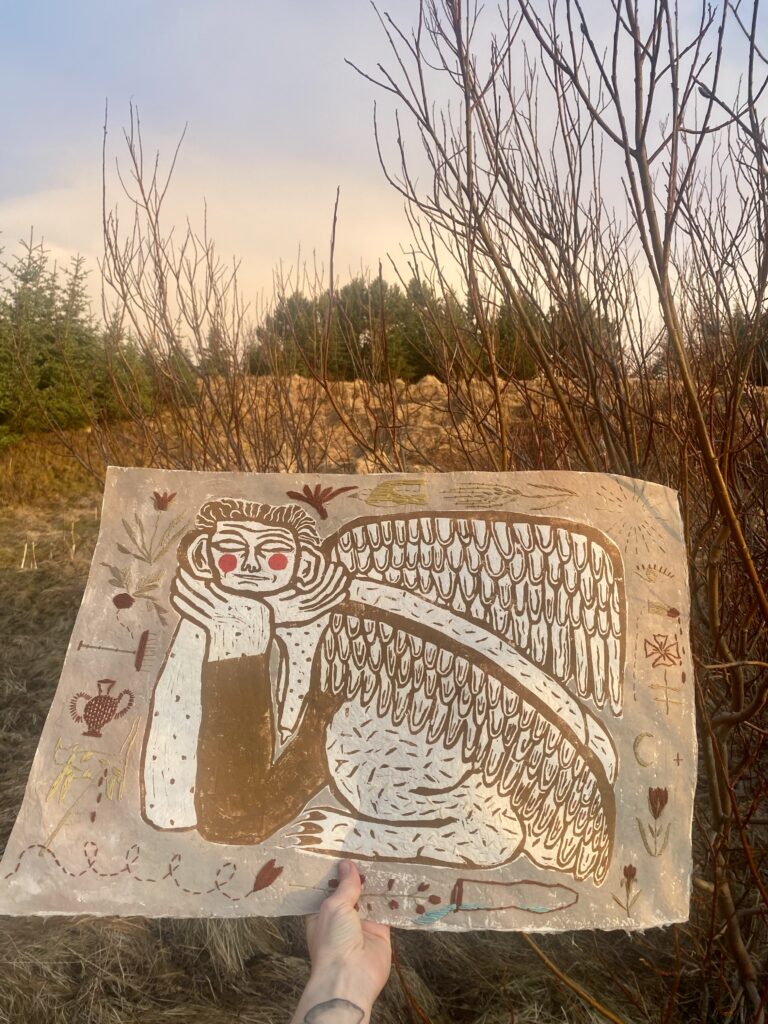
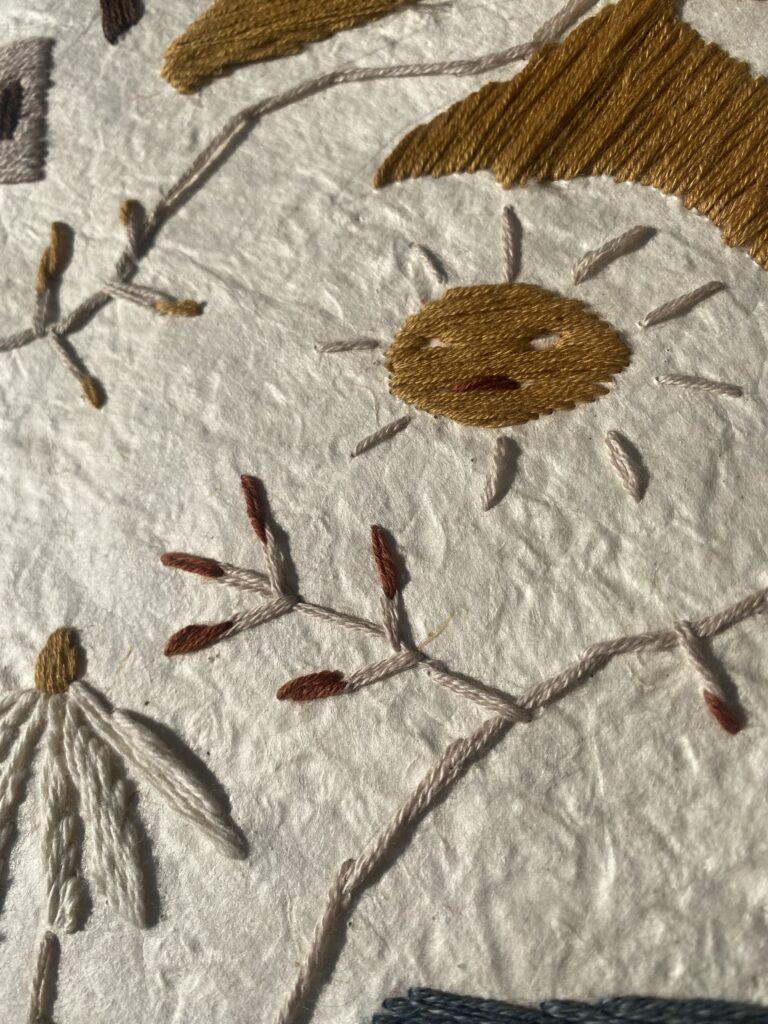

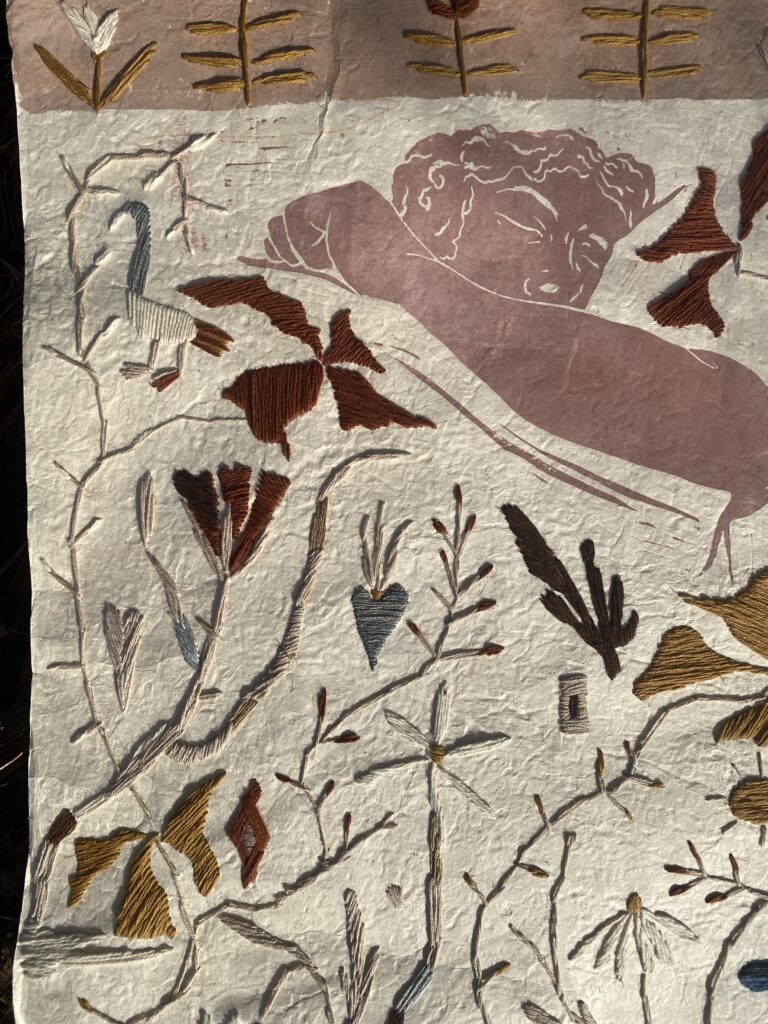
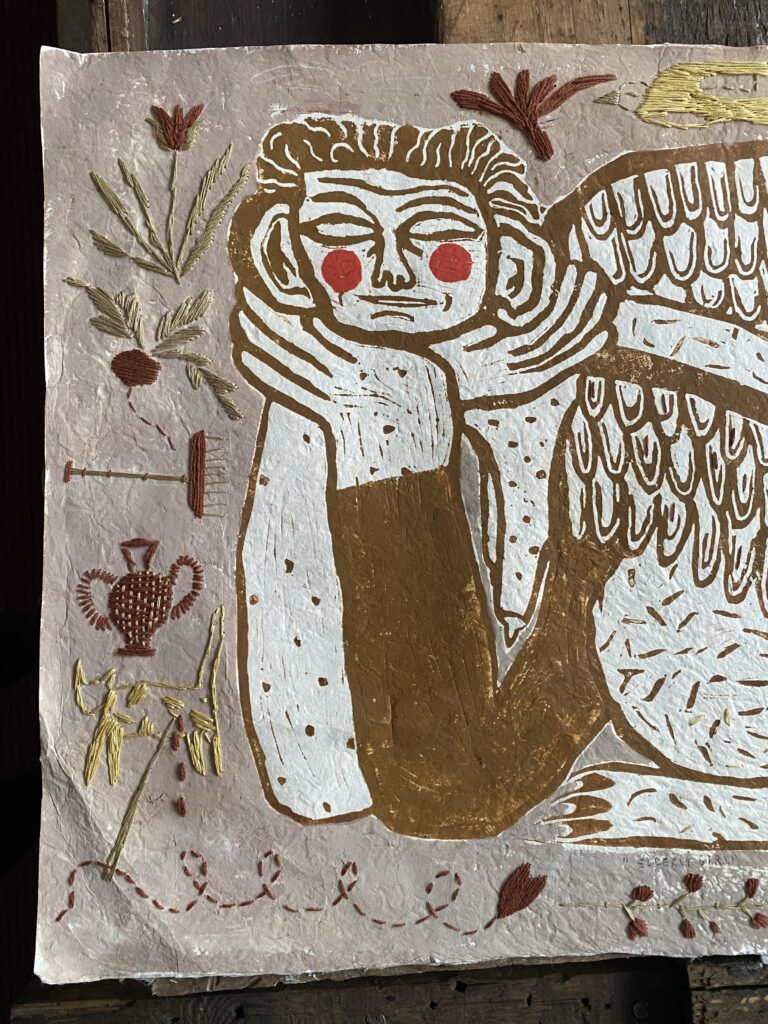

Residency > Meet the artists
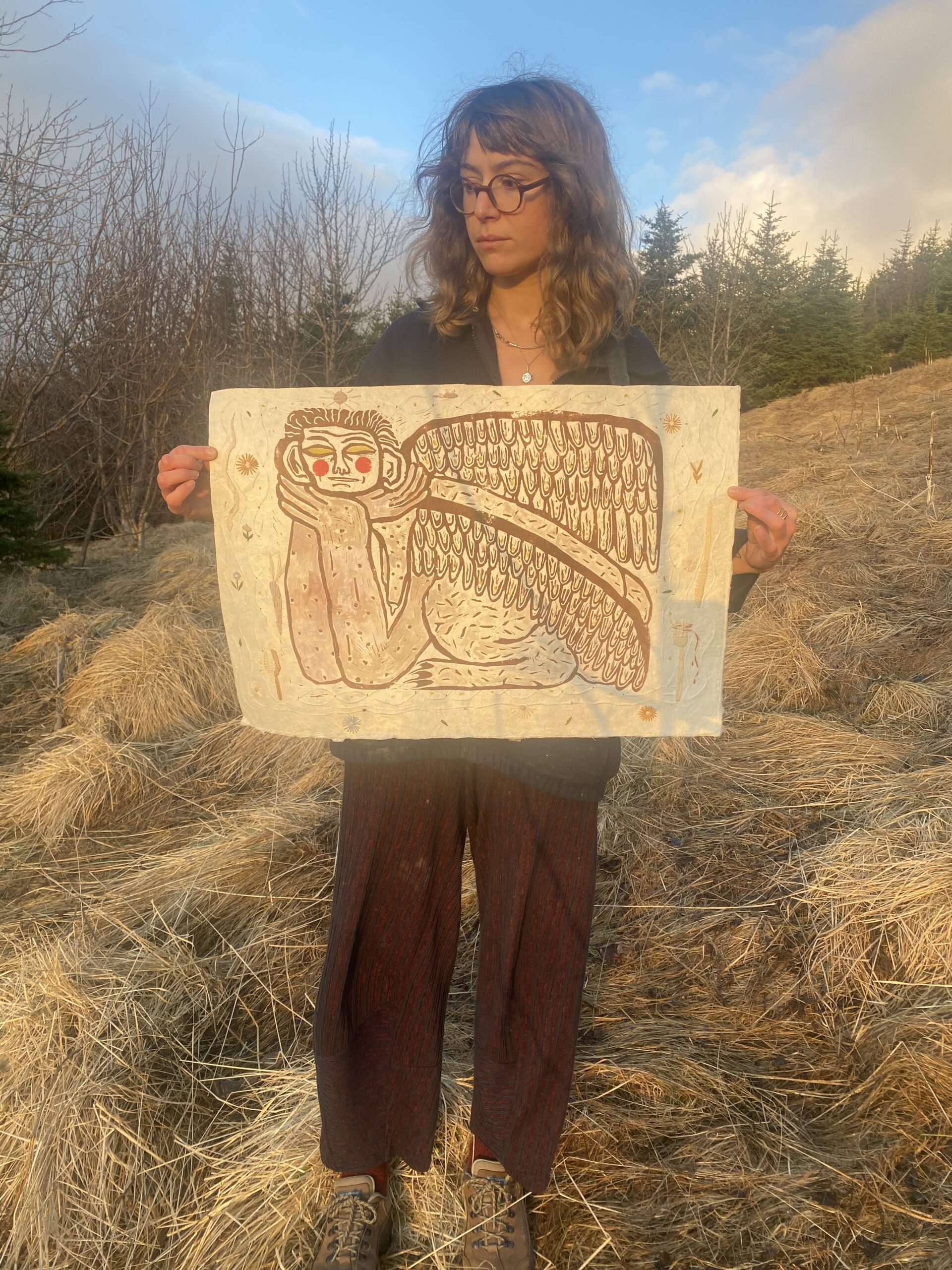
Ludovica Perosin is an artist based in Scotland.
She works with the themes of humor, drama, solitude and playfulness.
Mainly a print-maker, at Fish Factory worked on embroidery on paper.
She hopes her pieces speak for themselves.






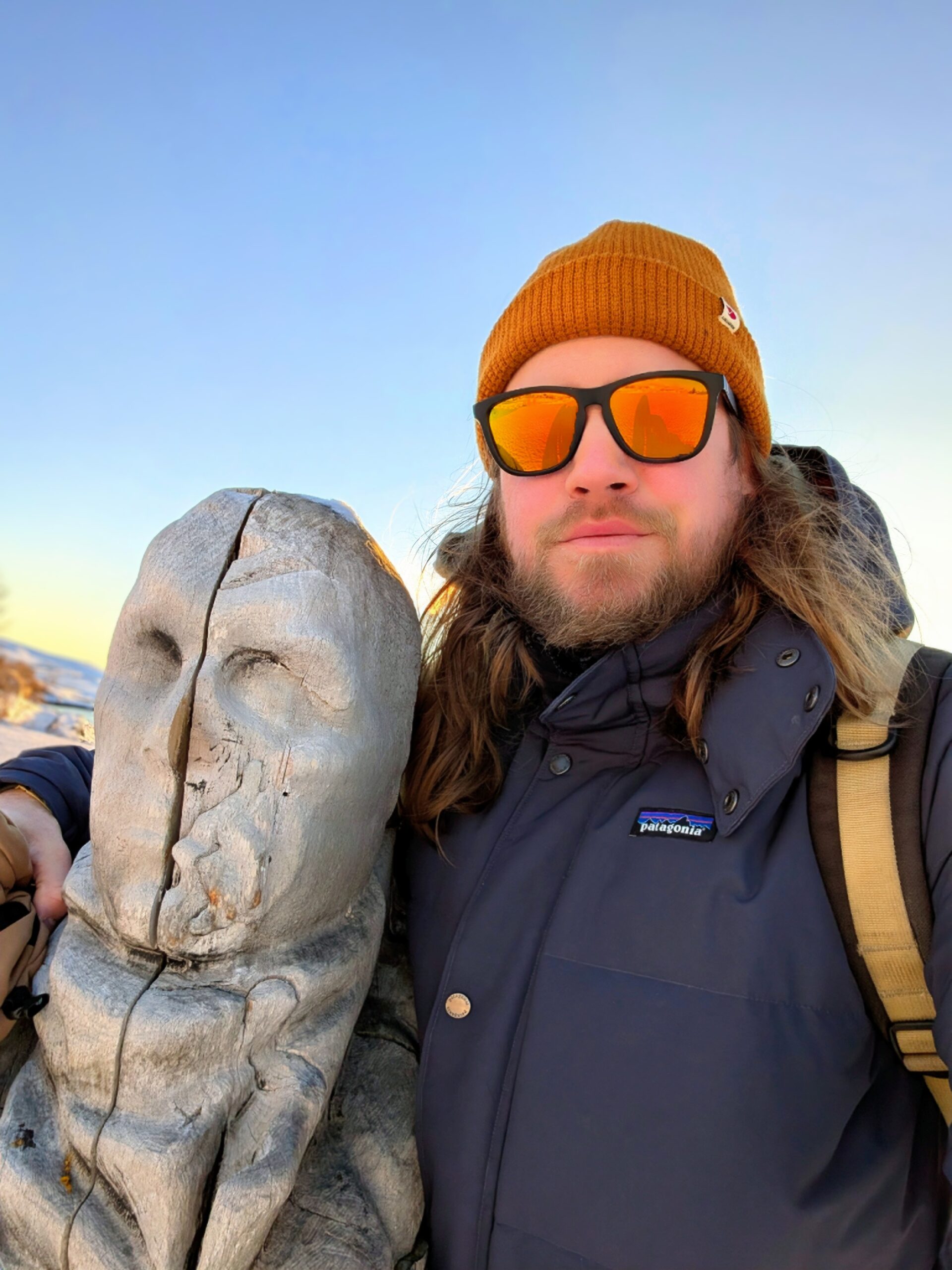
Chris Vola is a writer and bartender based in New York. A graduate of the Columbia University MFA program, he is the author of two novels, a collection of short stories, three books of poems, a coffee-table conspiracy theory book, and three books of cocktail recipes. His most recent work is The Cocktail Atlas: Around the World in 200+ Drinks, a collection of beverages from 195 countries and an exploration of global spirits culture.
I came to the Fish Factory because I wanted to flee the noise of the city to work on my next book, Drink One for the Team, which celebrates global sporting events by pairing them with appropriately themed cocktails. What I found in Stöðvarfjörður was less of an escape than a revelation, from the jagged exquisiteness of the mountains and fjords and drastically shifting weather to the hushed village streets and the inimitable energy of the studio.

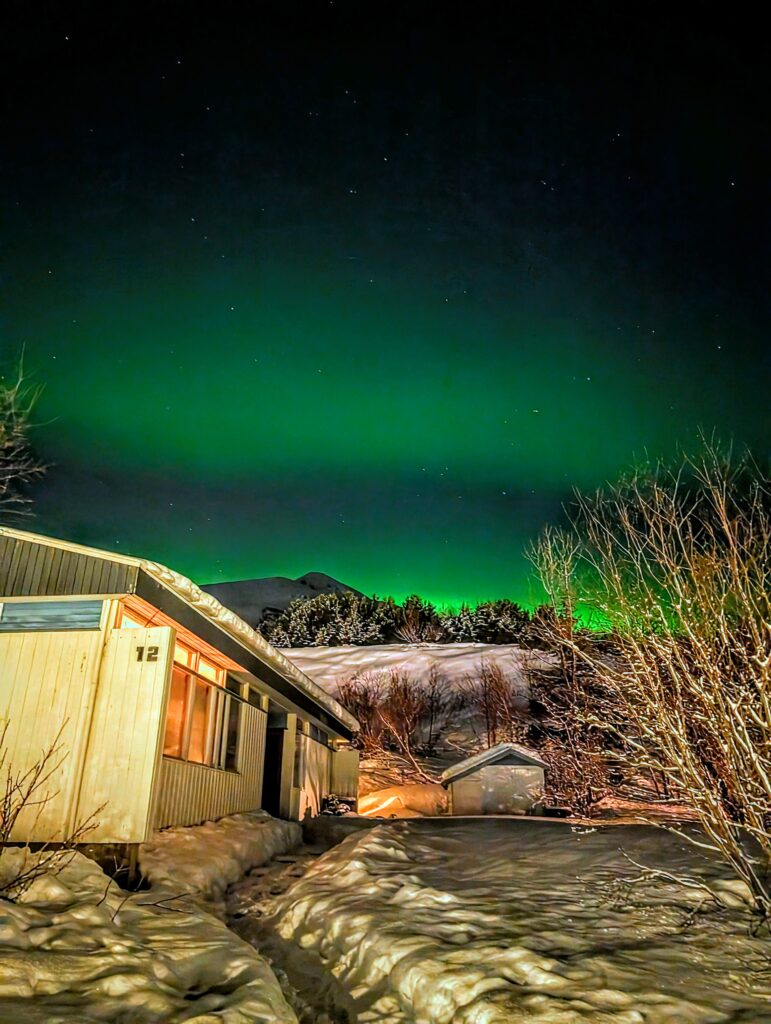
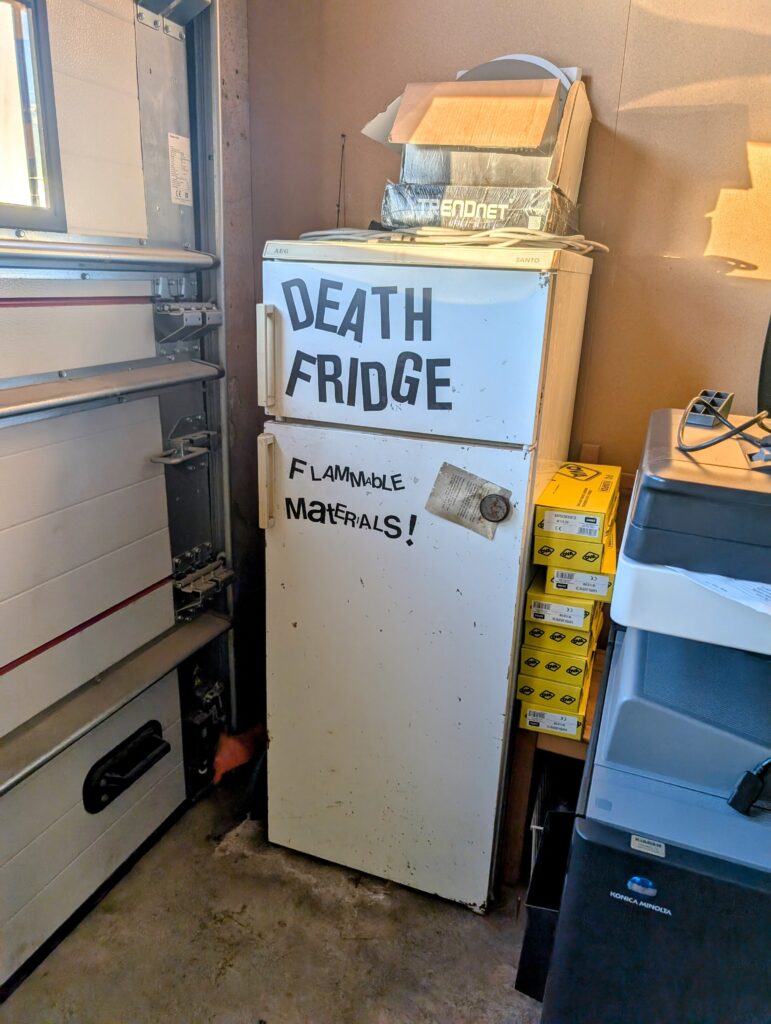
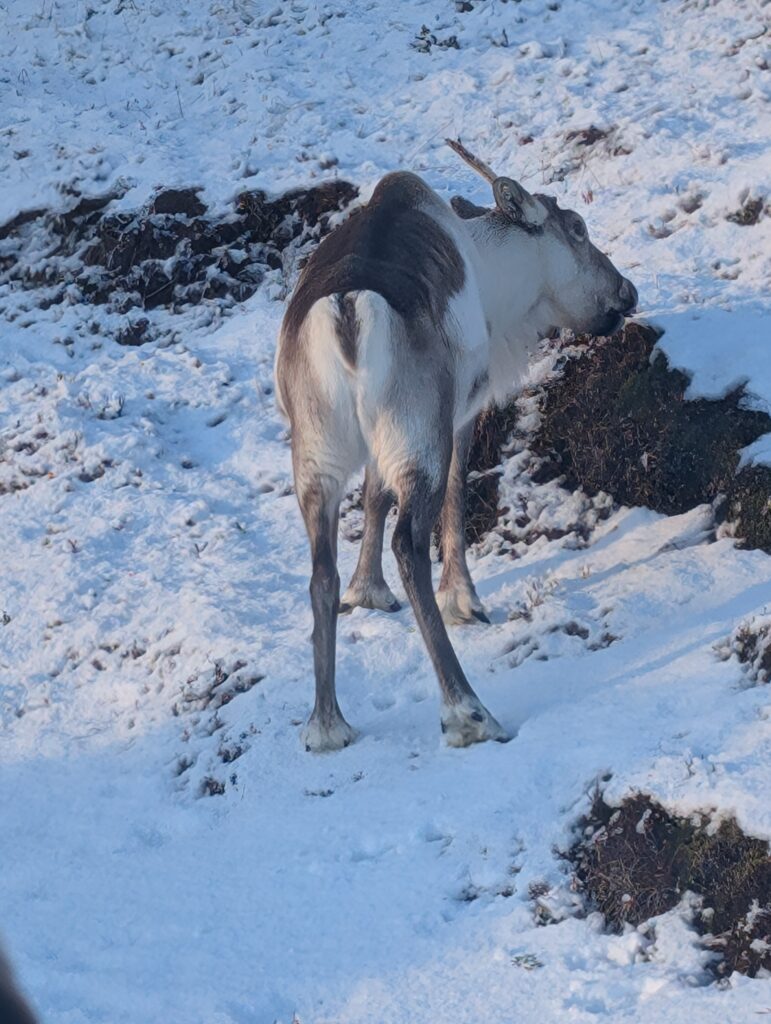
I finished as much of the book as I needed to – East Iceland in January isn’t exactly heavy on distractions – but the best moments had little to do with rigid productivity. Hiking to nearby beaches, geological formations, and the harbor (when there weren’t power-outage-inducing blizzards), chatting with other artists, vibing to live Icelandic punk rock, and taking in the aurora, polar stratospheric clouds, reindeer, etc., tapped into a creative flow state that had been absent for a couple years. I wrote some poems and restarted work on a collection of haiga – a Japanese artform featuring a short poem (haiku, senryu) combined with a visual element (photography in this case) – based on my travels in the Nordic countries. Stöðvarfjörður will undoubtedly feature heavily in the final version of the project. Something, along with my time at the Fish Factory, for which I will always be grateful.
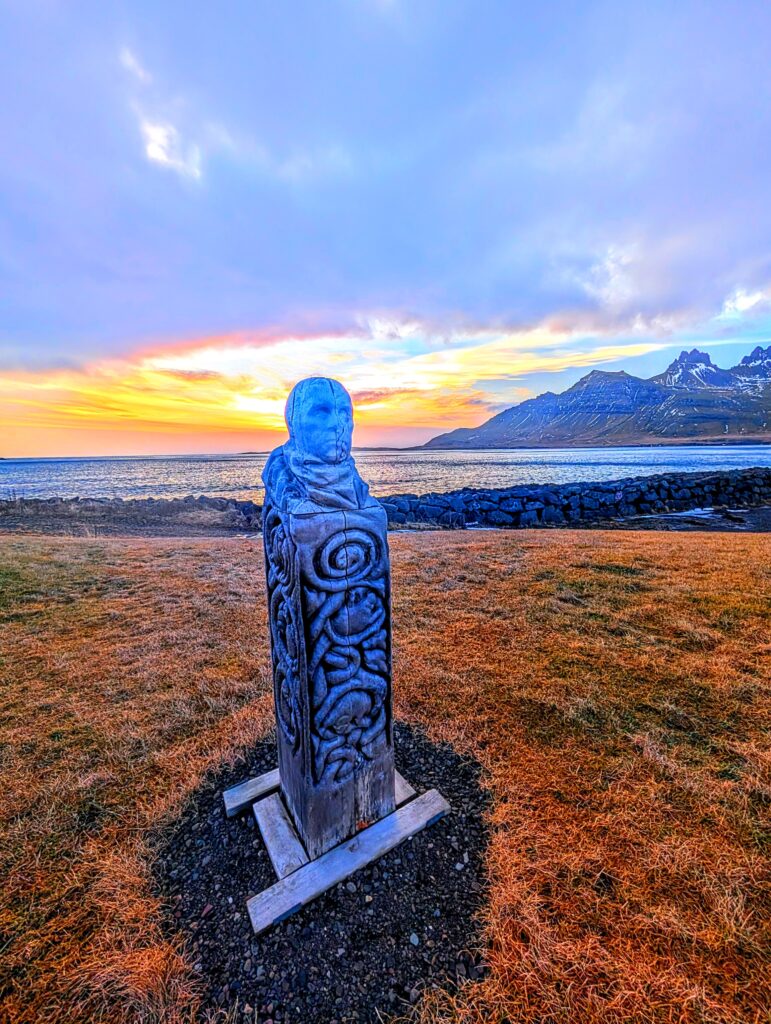
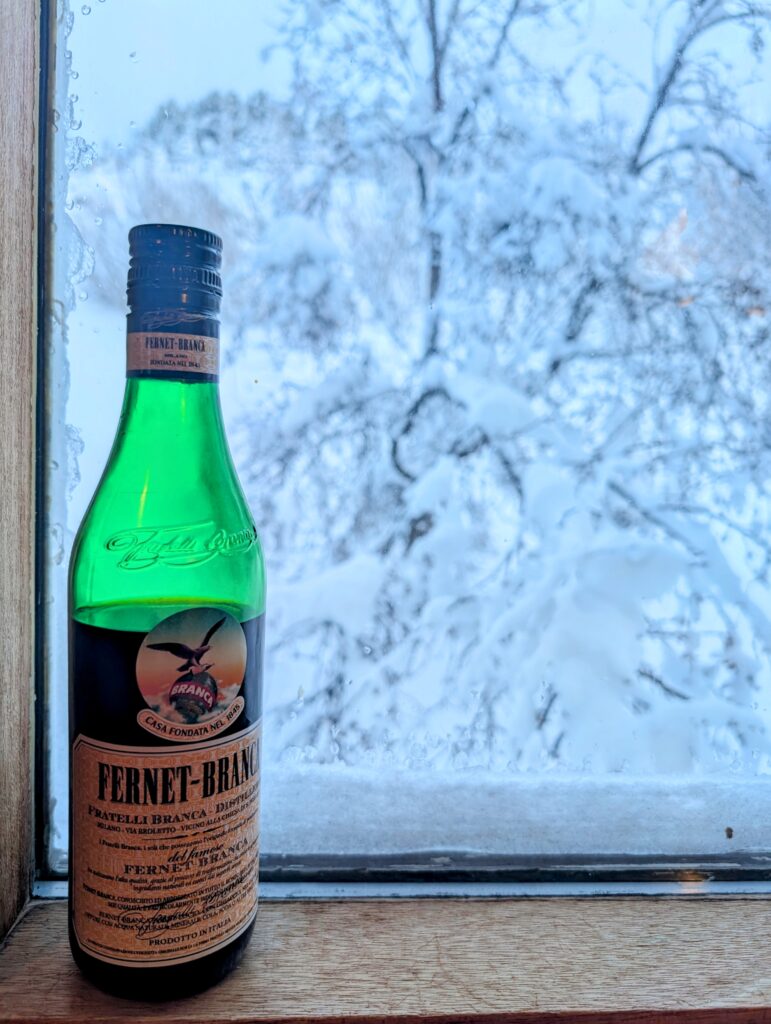
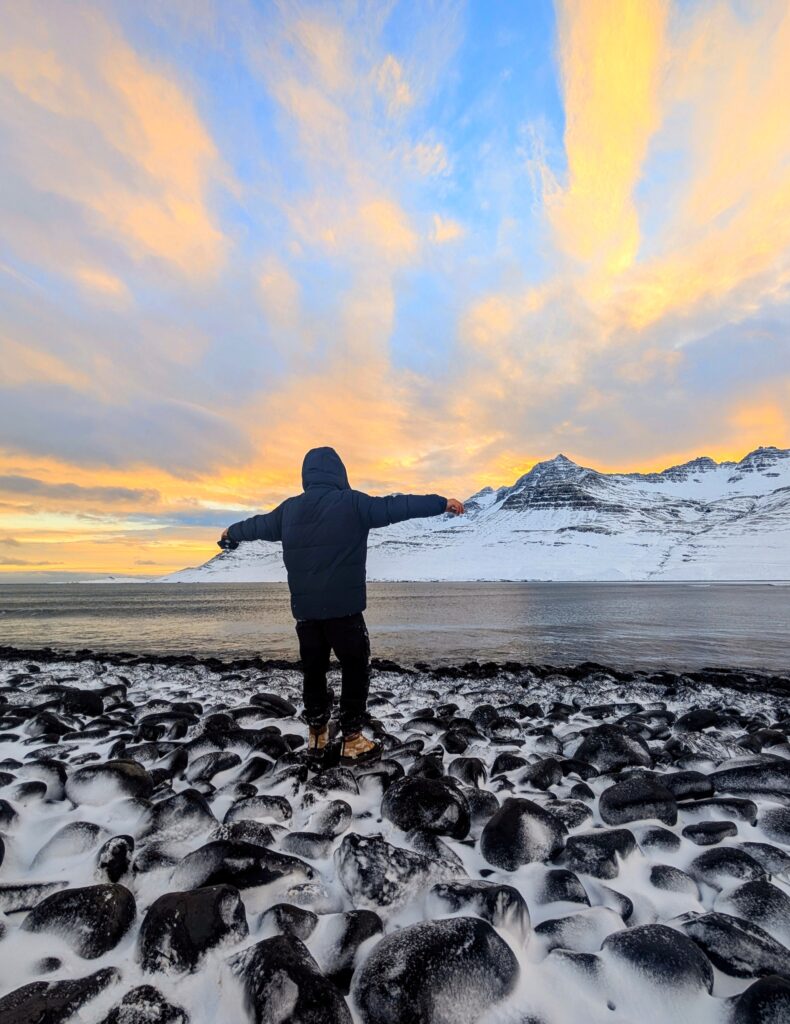
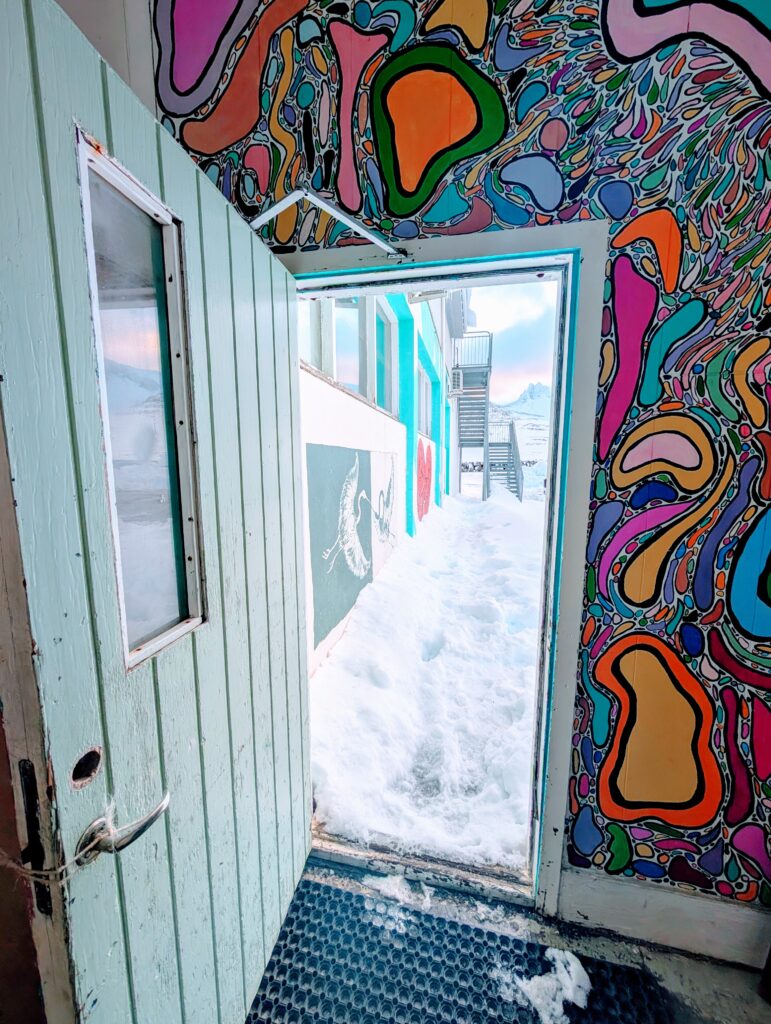
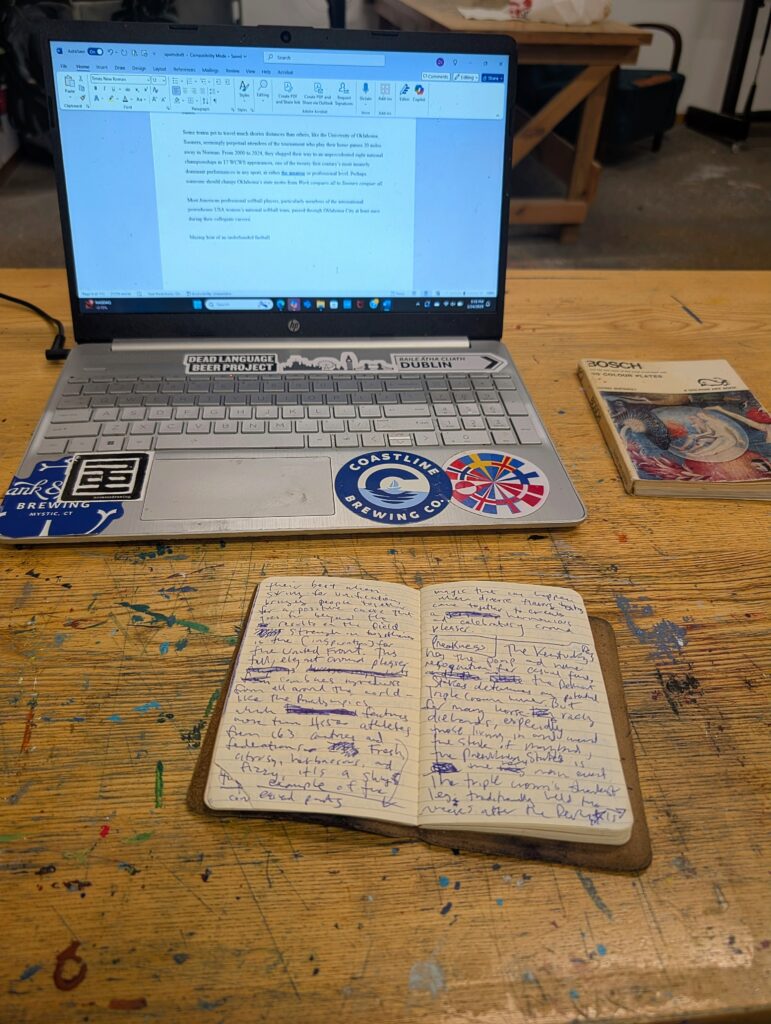
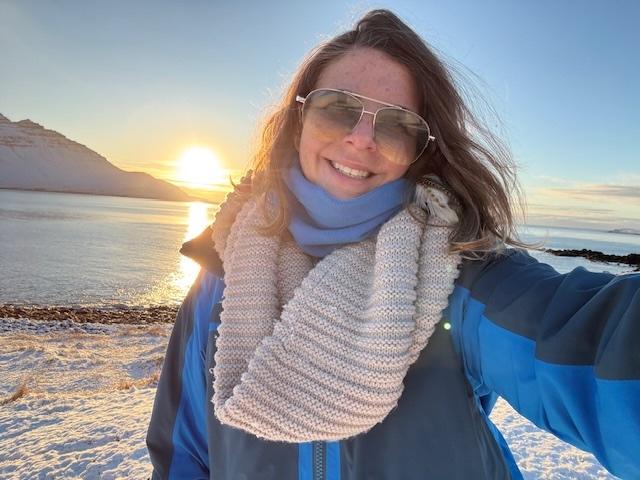
Kate Wurtzel (Ph.D) is a visual artist, art educator, and professor at Appalachian State University in North Carolina, United States. Her previous work focused on emergence, body movement while painting, and the importance of ritualization in the creative process for someone who is neurodivergent and has a physical disability. She initially went to the Fish Factory to investigate how her own non-abled body responded to the landscape, and to write and paint through the lens of embodied phenomenology, however when she arrived the work and some life elements took an unexpected turn.
In Kate’s own words, she explains: During my short stay at the residency we encountered severe weather fluctuations and at the same time I was going through some life changes as well. My body responded to the weather with tenacity, persistence, some anxiety and pain, as well as significant periods of joy and physical-emotional peace.
As a response to the environmental situation and the points of reflection in life, the work became less about physical-bodily responses and more about accessing internal strength and a need for more relational intimacy overall. Inspired by the quiet majestic strength of the mountains in the Eastfjords, and the deep and nearly primal connection to the land when in Iceland, the work shifted to reveal a desire for connectivity to spirituality, bodies, stories, ancestors, magic, and more.
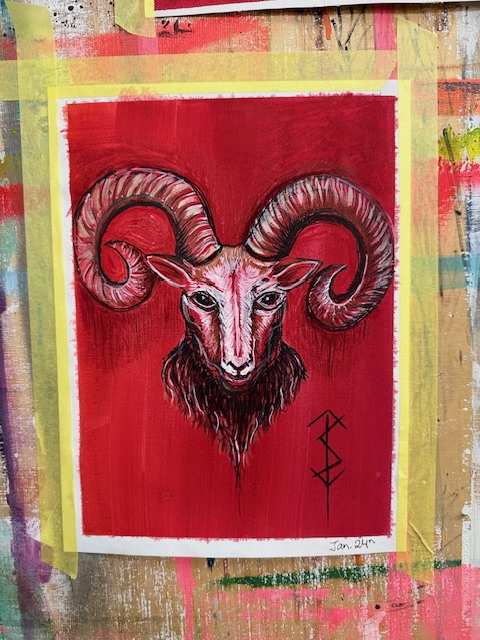
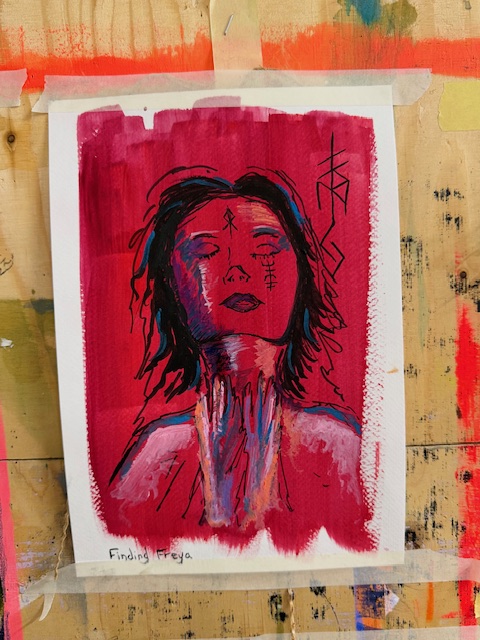
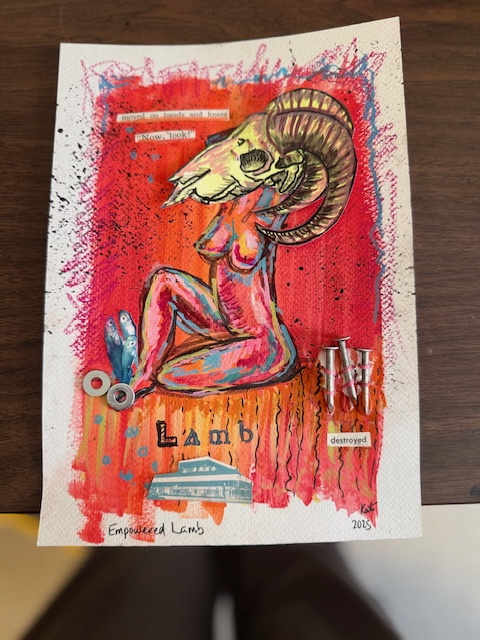

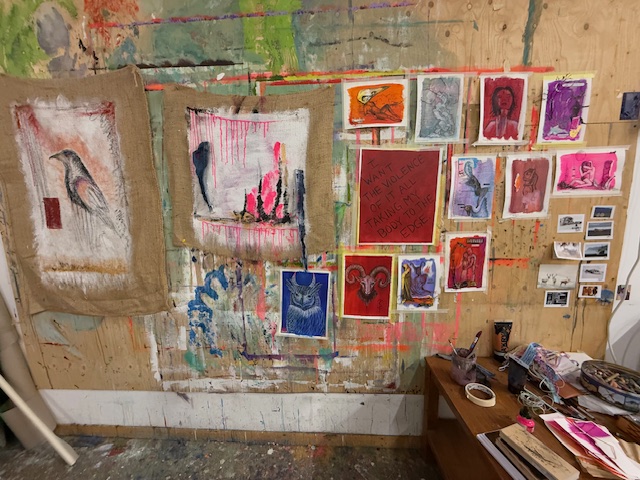
Consequently, my time at the Fish Factory opened an unexpected portal of desire; it revealed a need to understand my felt-embodied-connection to Iceland and investigate ancestral histories that touch-in to the supernatural and move beyond linear ways of knowing. The short, yet incredible, residency set me on a quest to know more about these deeply sensed experiences, including the complexity of relational intimacy, and the well of intra-connected ancestral strength we carry on an affectual level that often can only be accessed through creative gestures and sensed-ties to land/place.




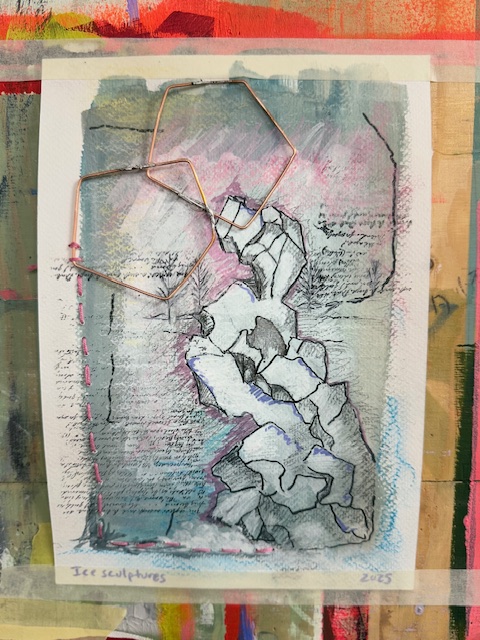
While the end result may not have been about the non-abled body in Iceland as planned, ultimately what emerged highlighted a need to move beyond the binary of abled/dis-abled, and instead reach for an expression of strength and connectivity in several ways.

Based in Dubuque, Iowa – as Midwest USA as it gets – Jenni Brant is a ceramicist, arts administrator, and advocate for community-driven creative initiatives. Her clay work is recognized for its distinctive color palette, slip-trailing technique, and attention to ornamentation in functional pottery.
During her November residency at the Fish Factory – Creative Centre, Jenni explored two creative directions: translating her recognizable pottery style into wearable ceramic accessories and experimenting with black porcelain, a stark departure from her usual pastel hues. Inspired by Iceland’s landscape and plant life, she adapted traditional forms and patterns, allowing the environment to shape new designs and techniques.
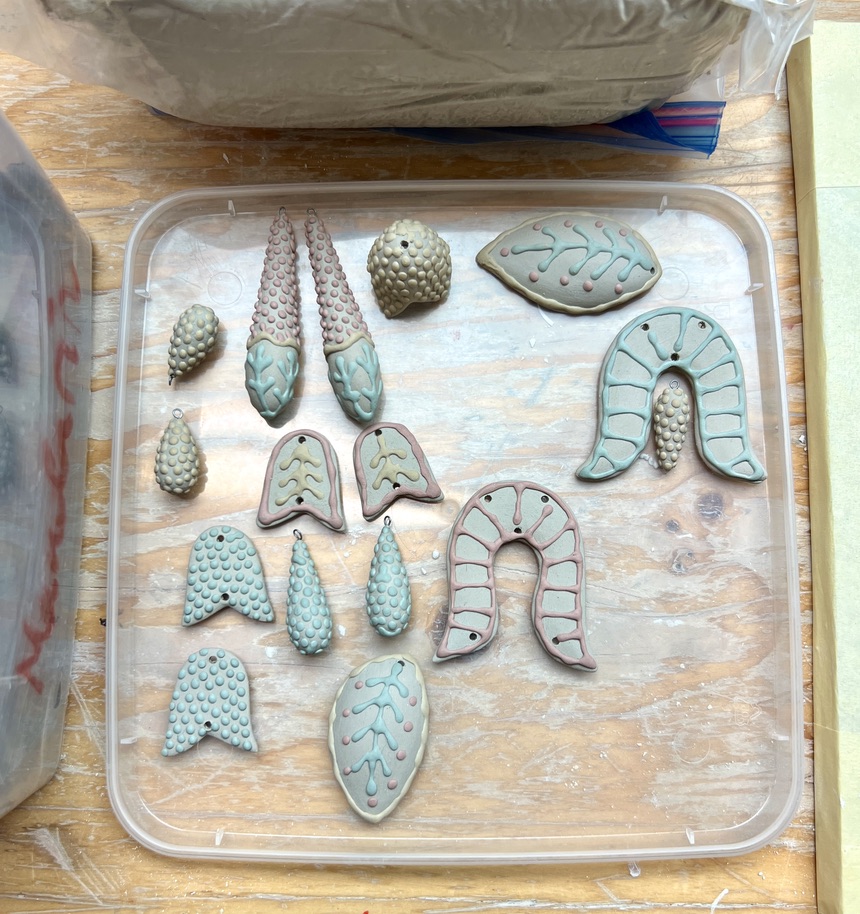

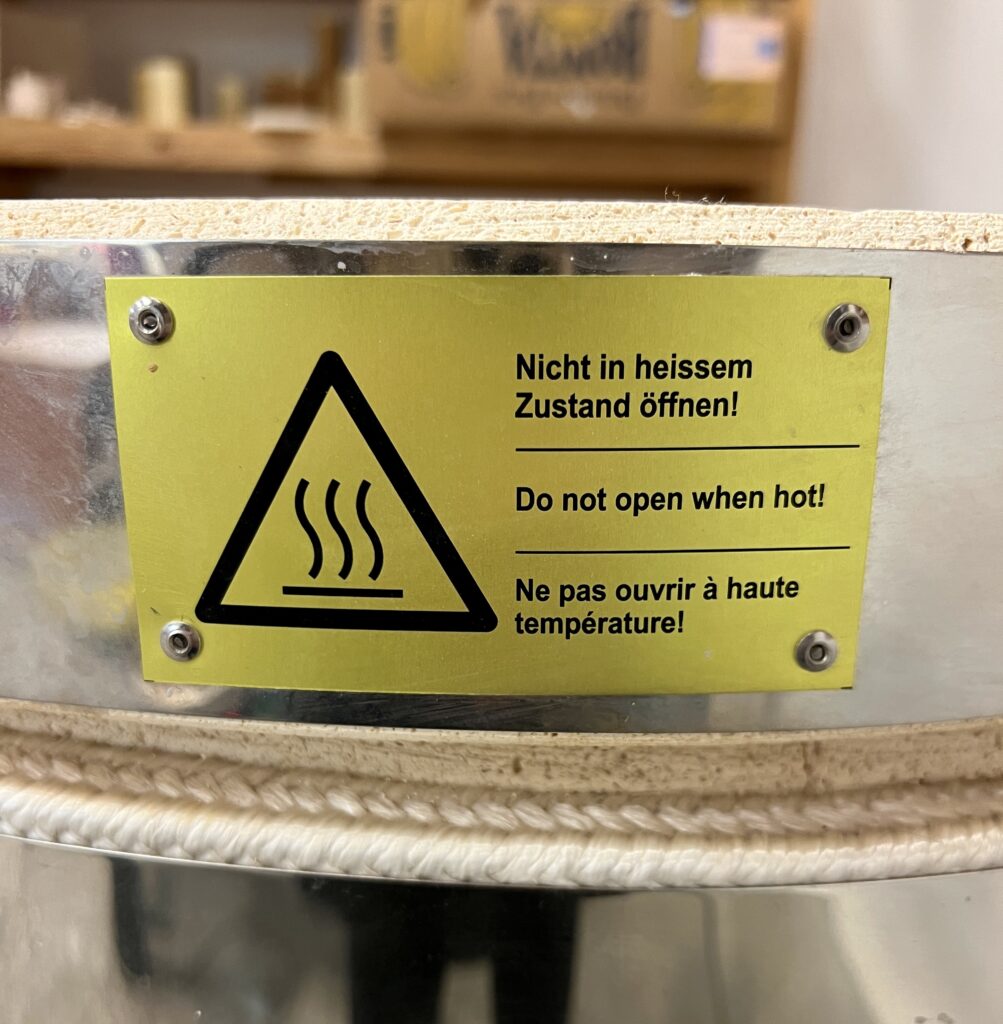
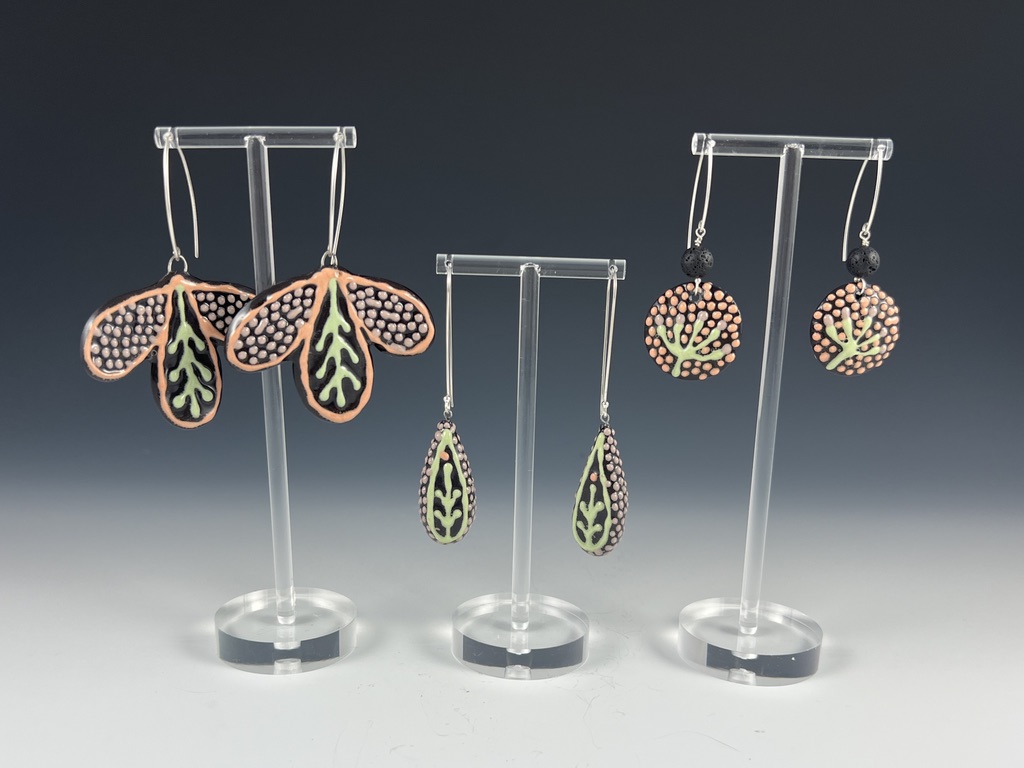
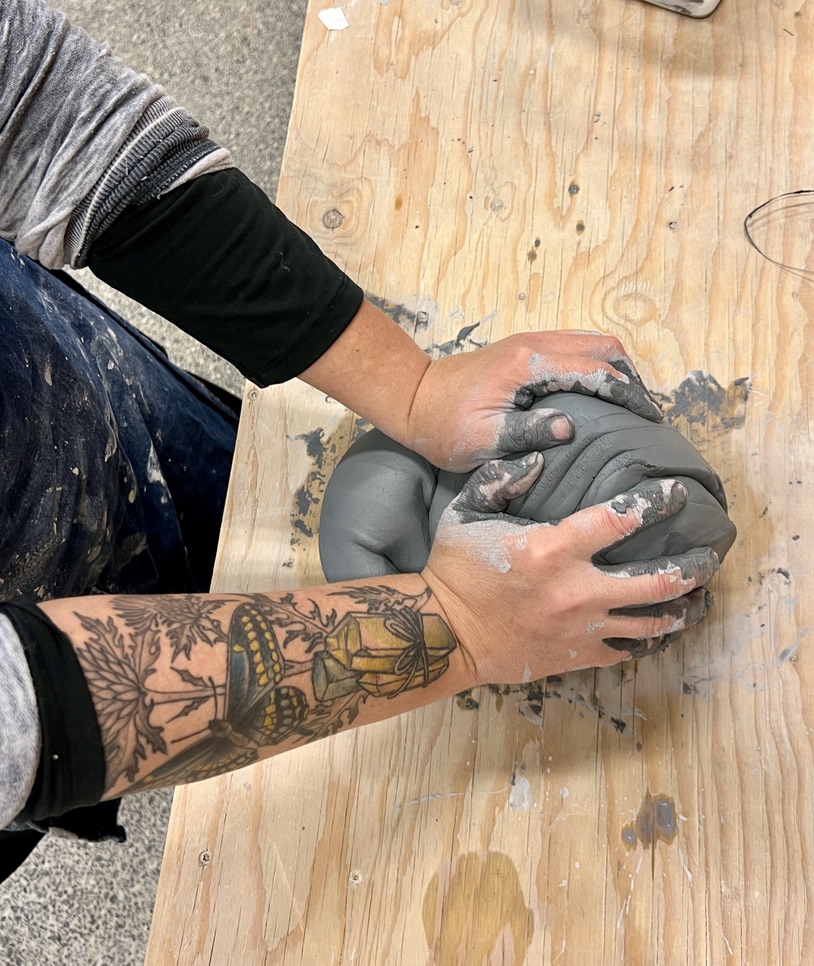

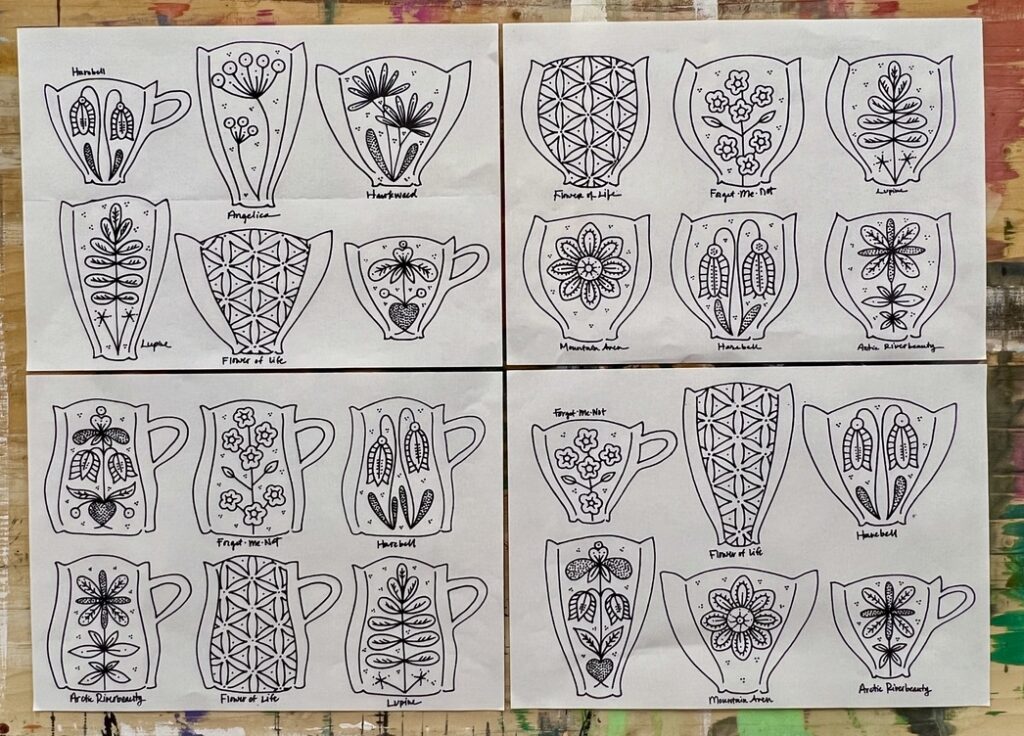
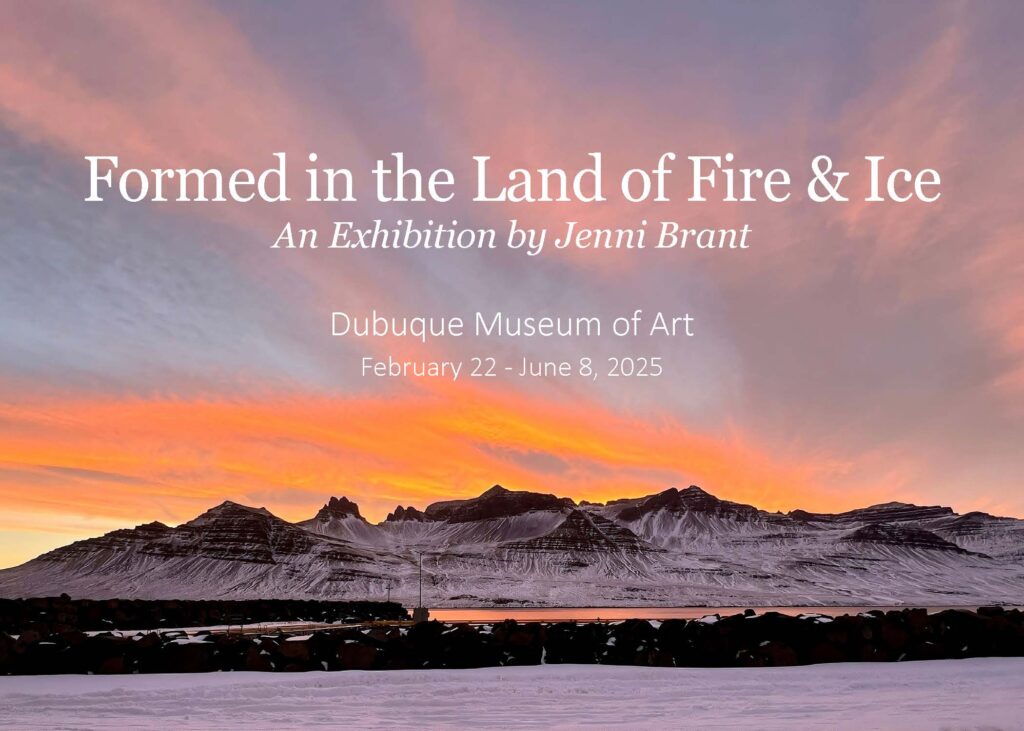

Formed in the land of fire and ice, where life pushes through volcanic rock and flourishes in the extremes, Jenni’s ceramics serve as quiet reminders of resilience, adaptation, and the deep connections that shape our journeys. Through these pieces, she hopes to share not just the visual beauty of Iceland but also the intertwining stories of loss, transformation, and the unexpected places where life—and art—take root.
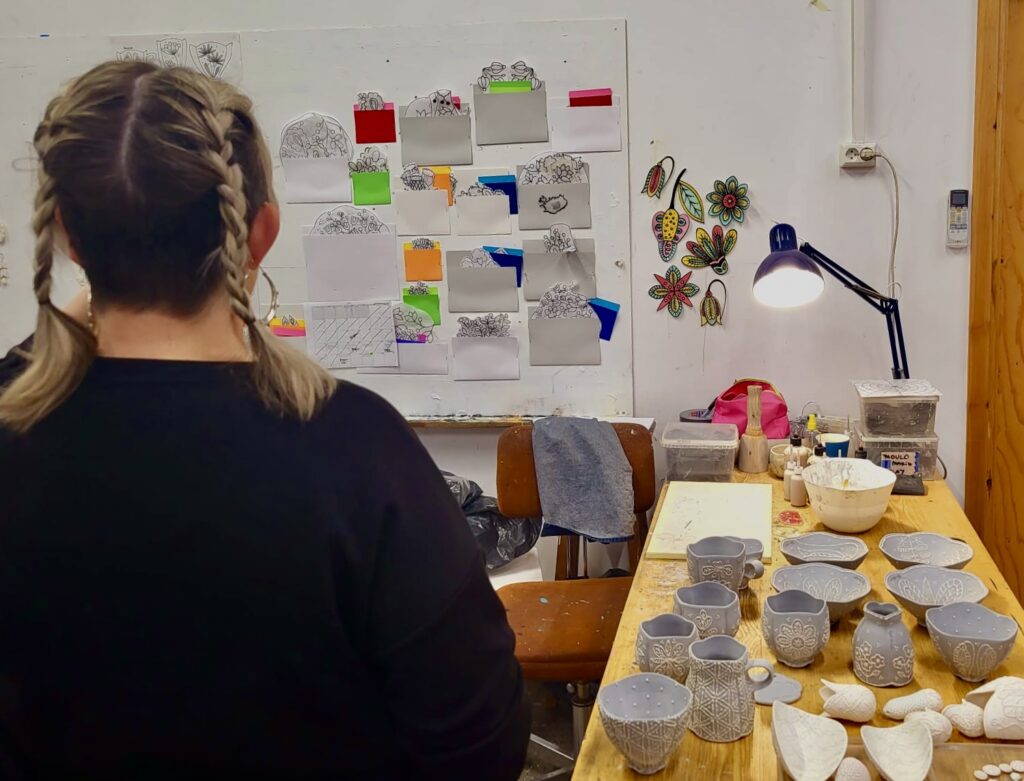
Now, through June 8, 2025, the work Jenni created in Iceland—along with photographs, videos, and journal entries documenting the residency—are on view in a solo exhibition at the Dubuque Museum of Art.

I’m an American multimedia artist with a background in theatre, photography, cinema, stone carving and, most recently, clay. After graduating from New York University’s Tisch School of the Arts with a BFA in Drama, I left the acting world to study performance and media at the University of Texas at Austin and, later, filmmaking at EICAR, the International Film & Television School in Paris, France.
While I have moved between different industries and art forms over the years, all of my aesthetic work is connected by a love of light, color and rhythm as well as a tactile investigation of the invisible energetic threads tying elements together in both the natural environment and the social, human world.
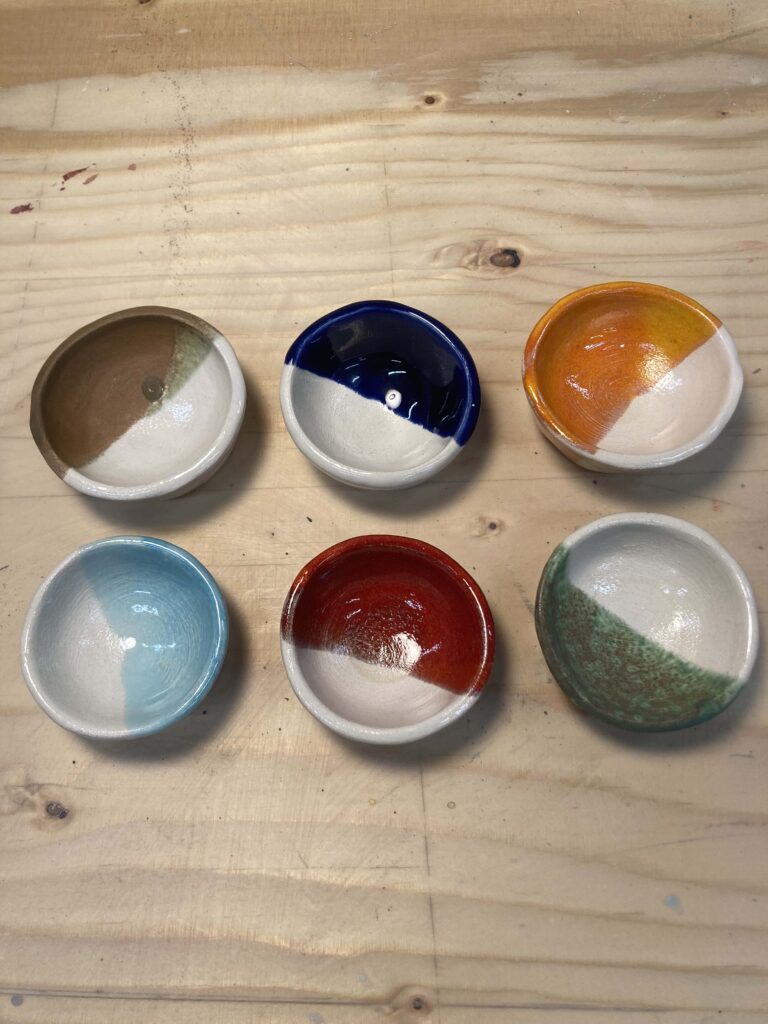
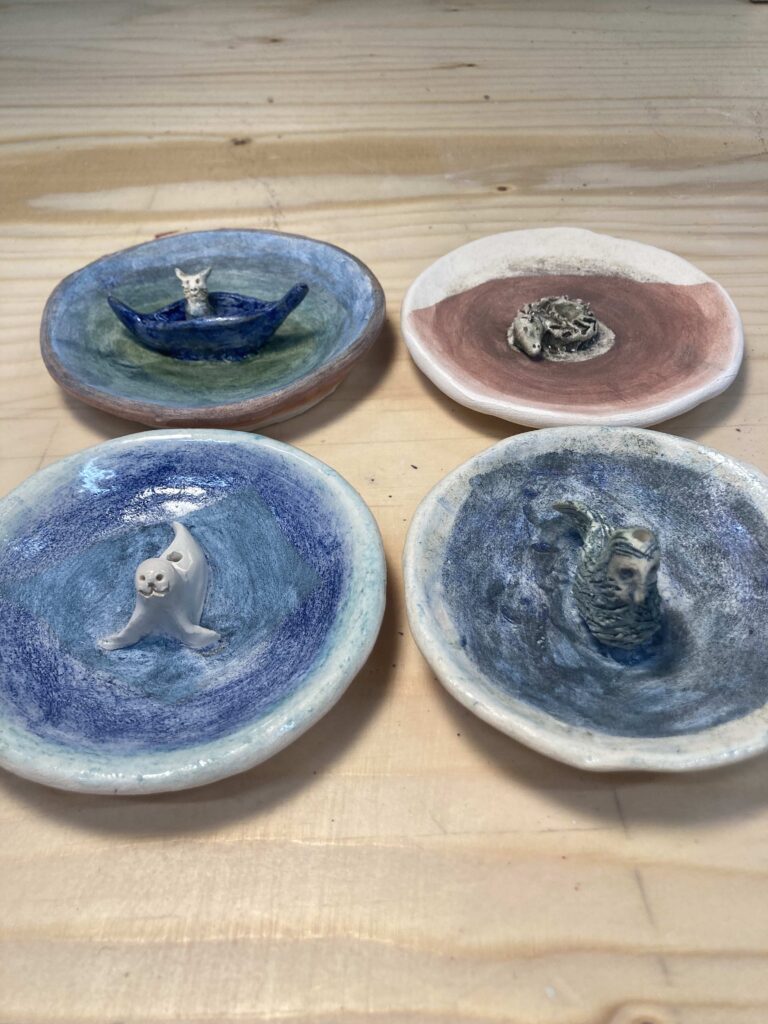
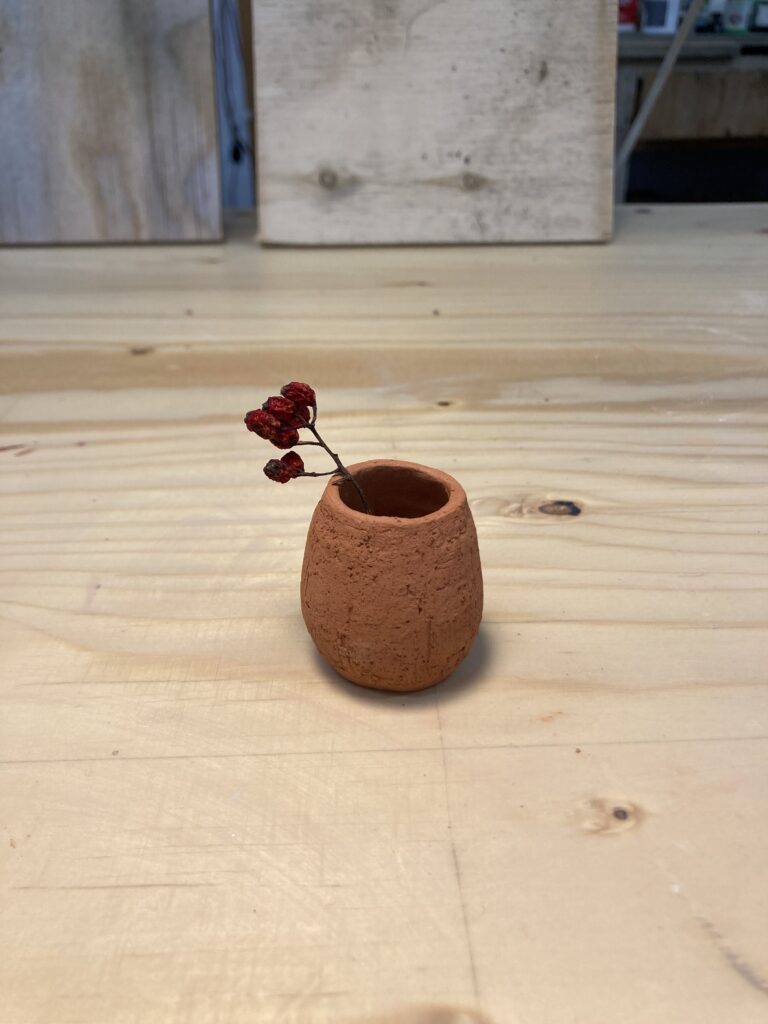
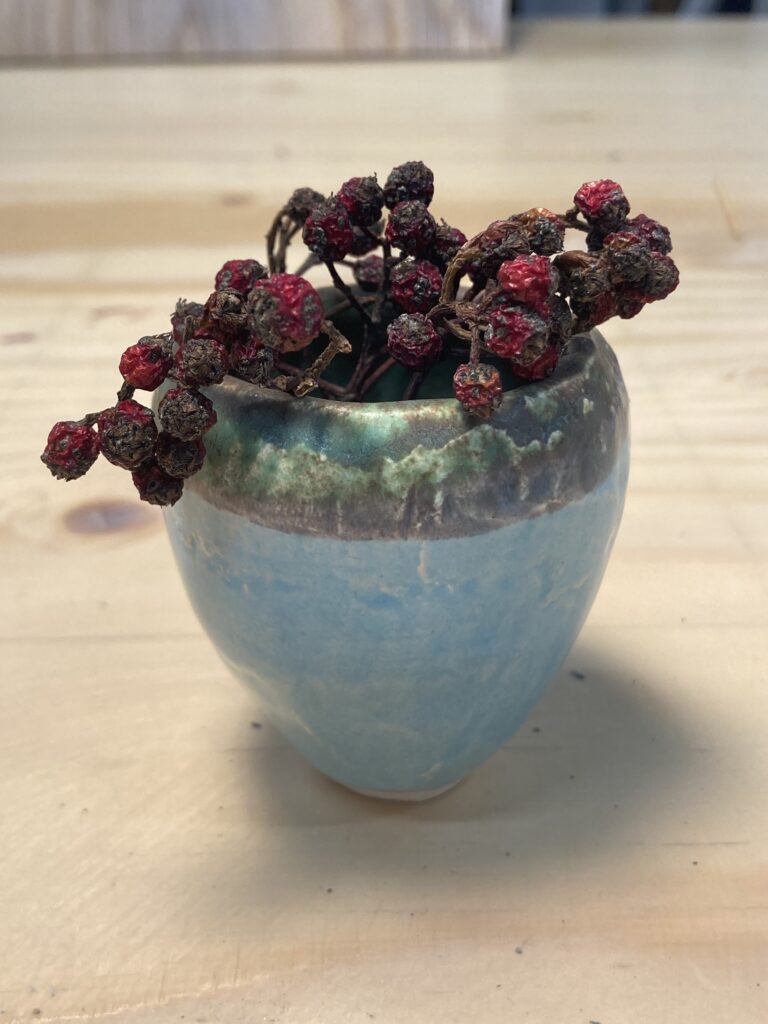
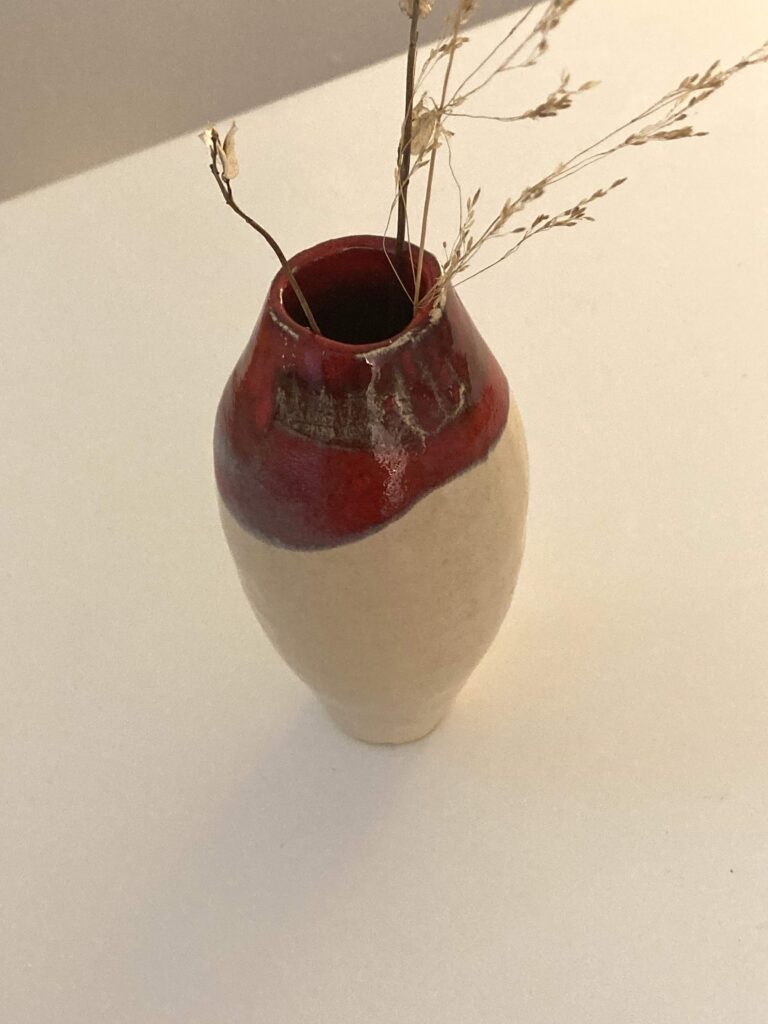
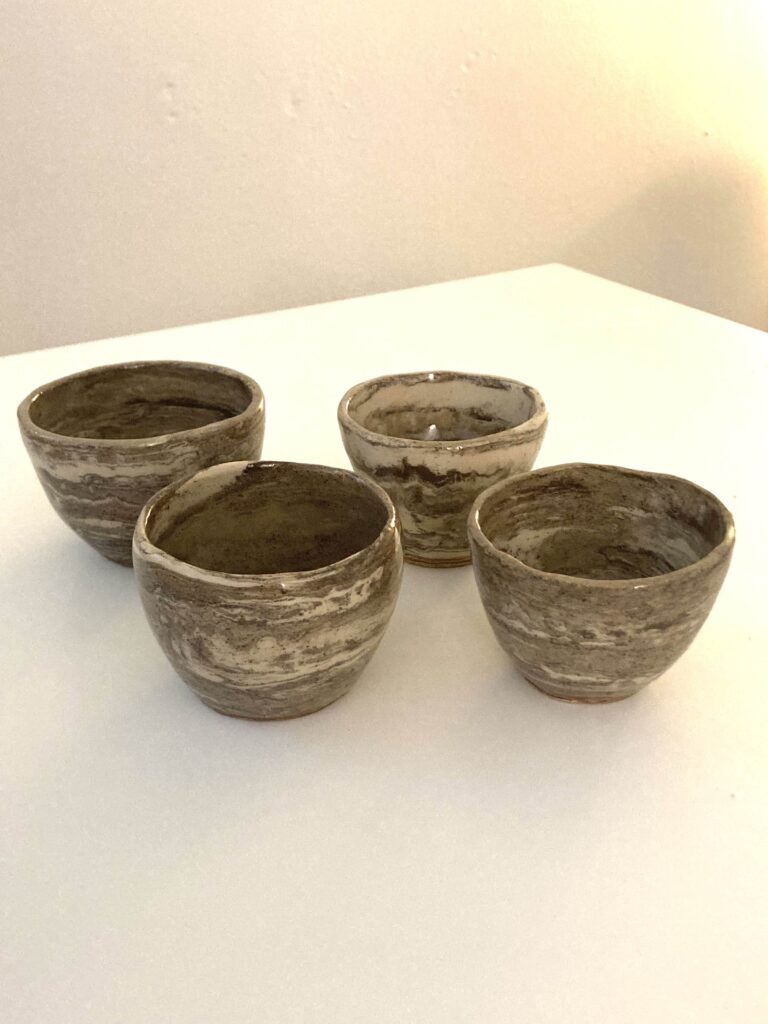
During my time at the Fish Factory, I fell in love with the Icelandic landscape and its constantly changing patterns of weather, light and color — an awe-inspiring spectrum I have never seen before. I was also inspired by the generous interdisciplinary exchange of cultural and artistic ideas among our dynamic, talented group, which I believe advanced my own practice by leaps and bounds. Every day in Stödvarfjördur brought the gift of something new, and I will always be grateful for this unique experience on a personal as well as a professional level.
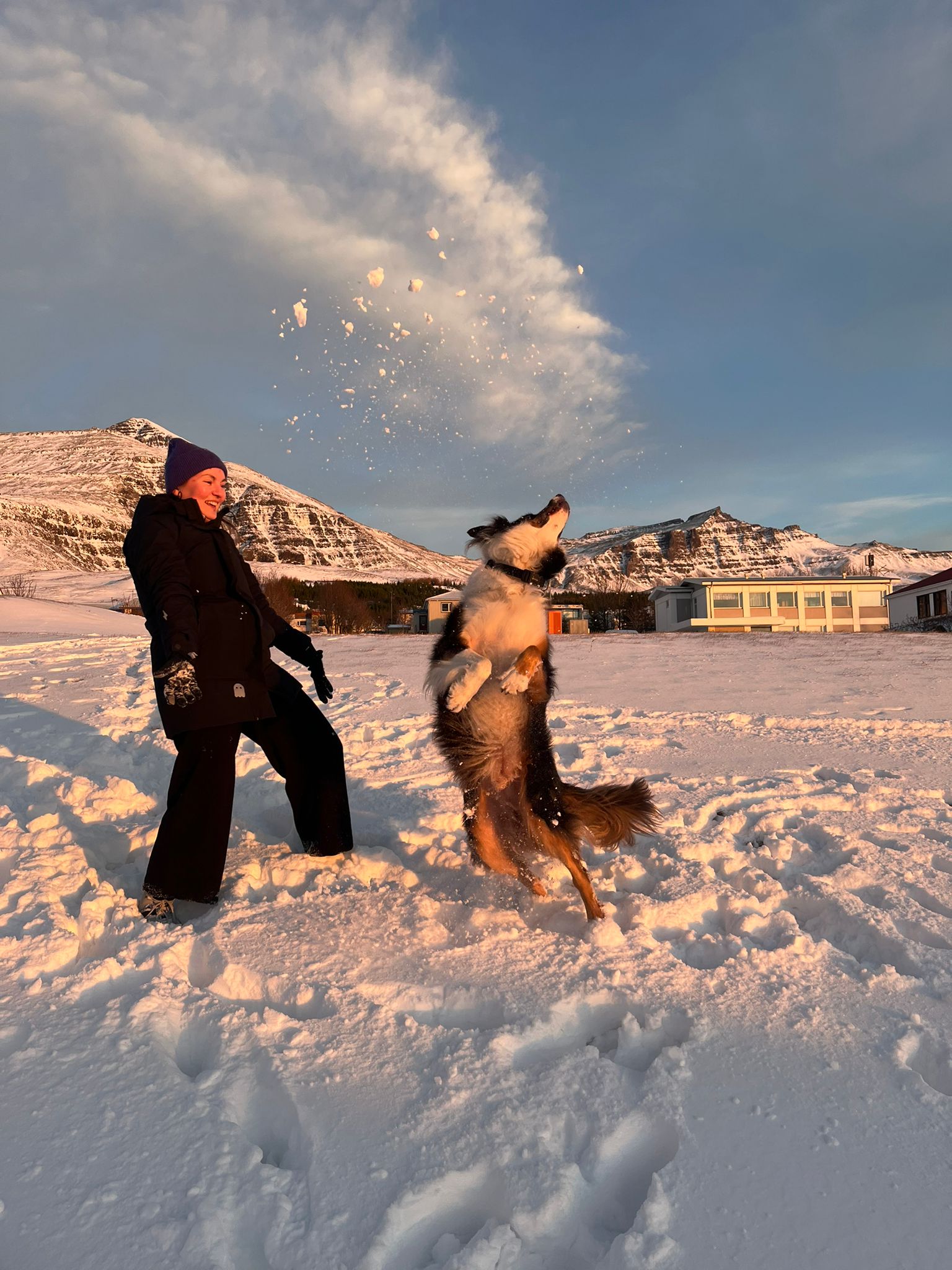
Tereza Kociánová, born in the Czech Republic and now residing in Akureyri, Iceland, is a visual and mixed textile artist.
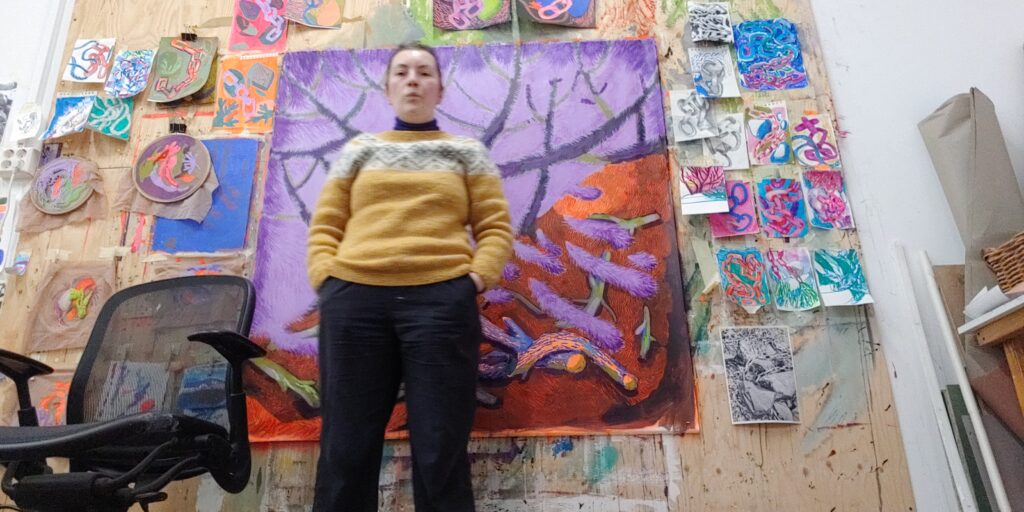
She holds a BA in Textile Design from the Academy of Fine Arts and Design in Bratislava, Slovakia, and studied a MA in Print Textile from the Academy of Fine Arts in Lodz, Poland. Additionally, she completed her studies in Graphic Design at Myndlistaskóli Akureyri.
Her work is characterized by a bold use of vivid, contrasting colors and a distinctive approach to form and texture. Tereza’s artistic practice involves translating elements of the natural landscape into abstract forms that merge the external environment with interior spaces. This is evident in her paintings, where fluid lines
and vibrant color palettes create dynamic interpretations of landscapes, as seen in her work that evokes both familiarity and dreamlike states.



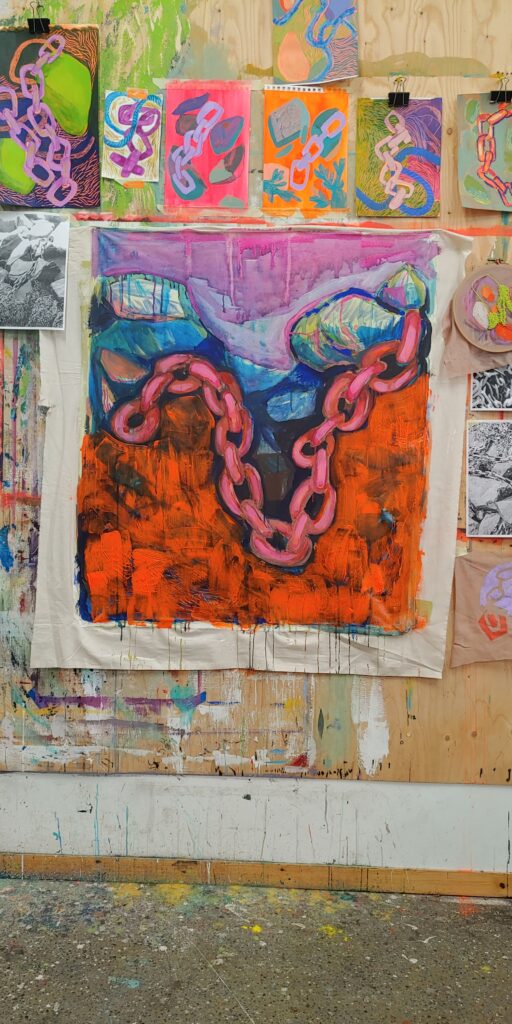
The Fish Factory residency felt like a chain reaction in every sense. Even though I live in Iceland, I had never spent much time in the Eastfjords before, and the experience gave me a fresh perspective on the country I call home. The chains on the stones at the harbor immediately captured my imagination, sparking a new direction in my work.
I began by painting a canvas with the theme of chains, which I later transformed into a chainshaped soft sculpture.
This process of shifting between 2D and 3D became central to my explorations. I also experimented with clay, creating countless versions of chains—from sturdy, solid loops to fluid, melting shapes. Each piece felt like it connected to the next, forming a larger narrative of material, form, and transformation. The Eastfjords, the harbor, and the creative space at the Fish Factory all came together to inspire a
body of work that feels deeply tied to this place. It wasn’t just about creating—it was about connecting: with the landscape, the people, and the ideas that came to life here.

Lily Petch is a visual, multidisciplinary artist and writer from Worthing/London UK.

Her practice ruminates on the capacity writing has to outlive the human body. This takes visual form in text, land art and installation based work, embedded sensitively into rooms, institutions and environments. Her installations display fictional and poetic arrangements of objects centred around books or text, sometimes paired with her own field recordings. Petch’s work encourages the symbolism and fragility of chosen materials which relate to the preservation and history of inscription. She prompts the potential these materials have to collapse or endure erasure, often when exposed to environmental factors.

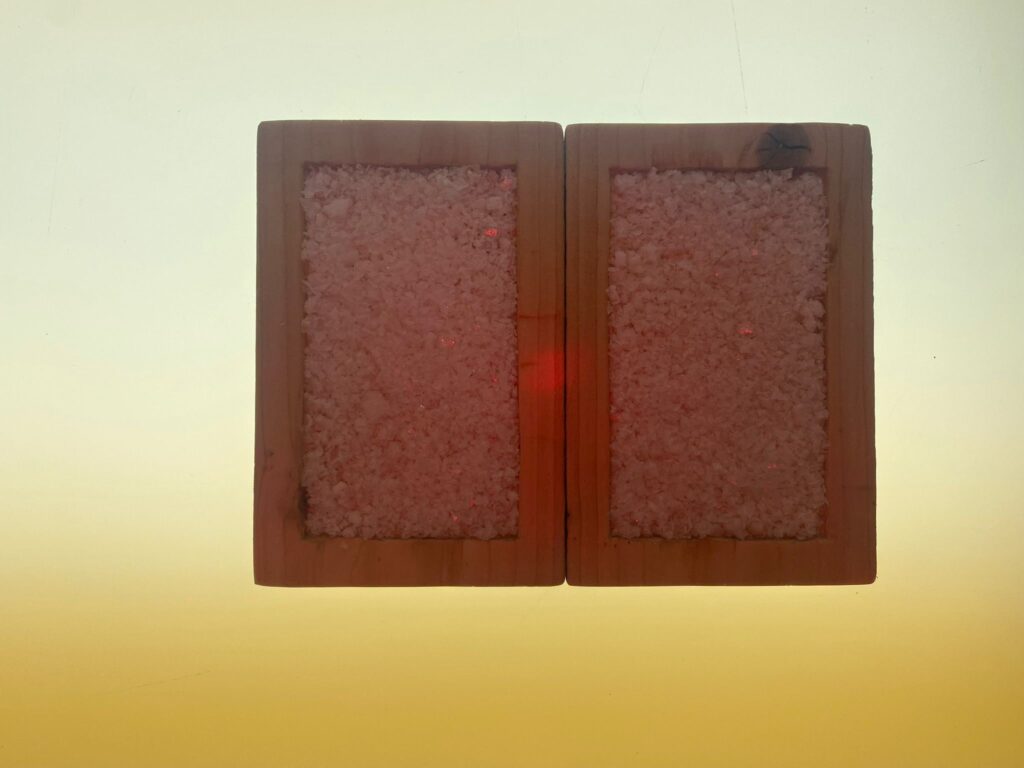

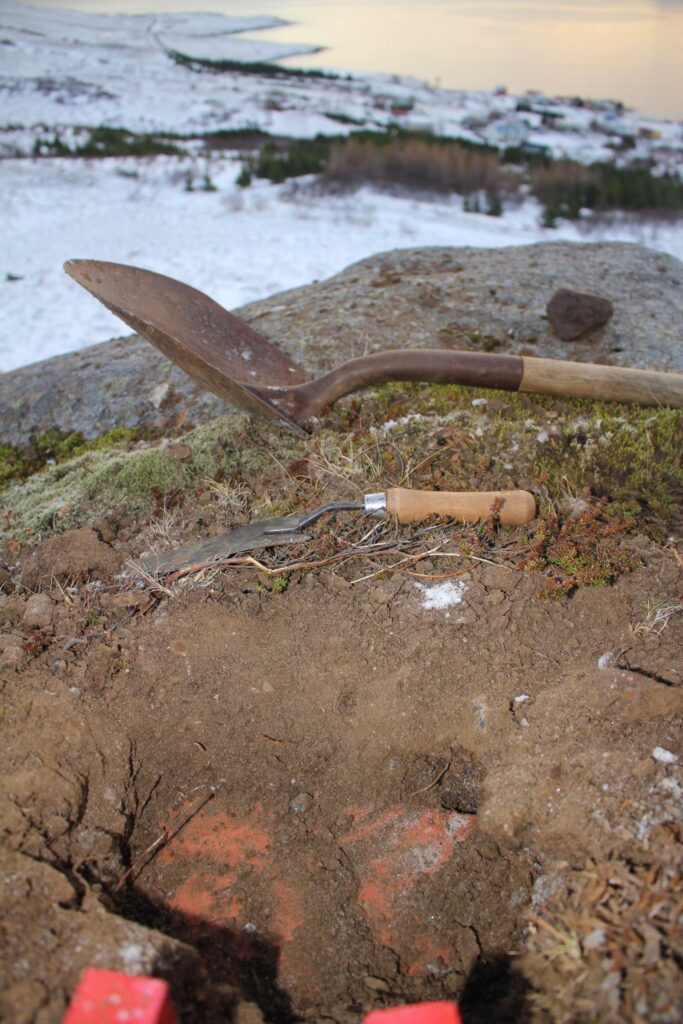
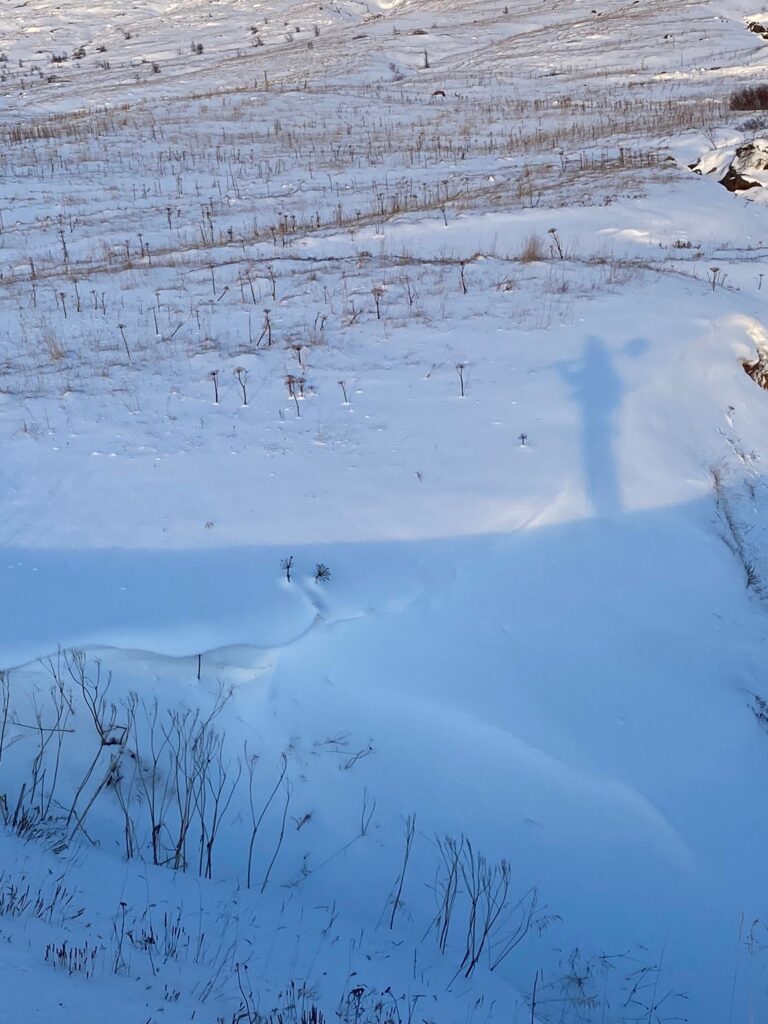
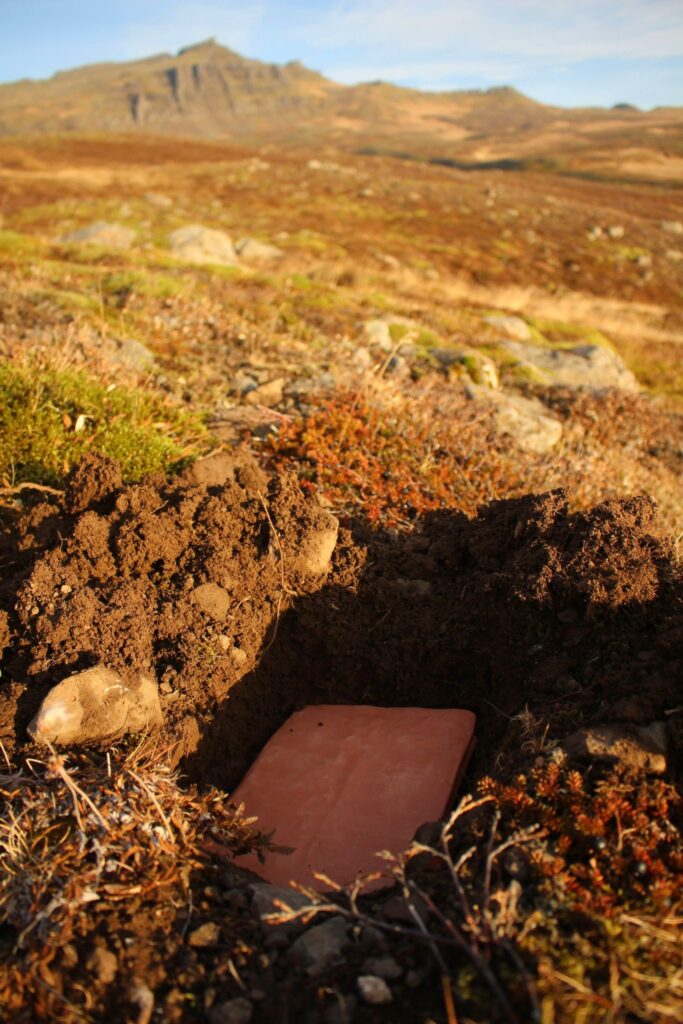
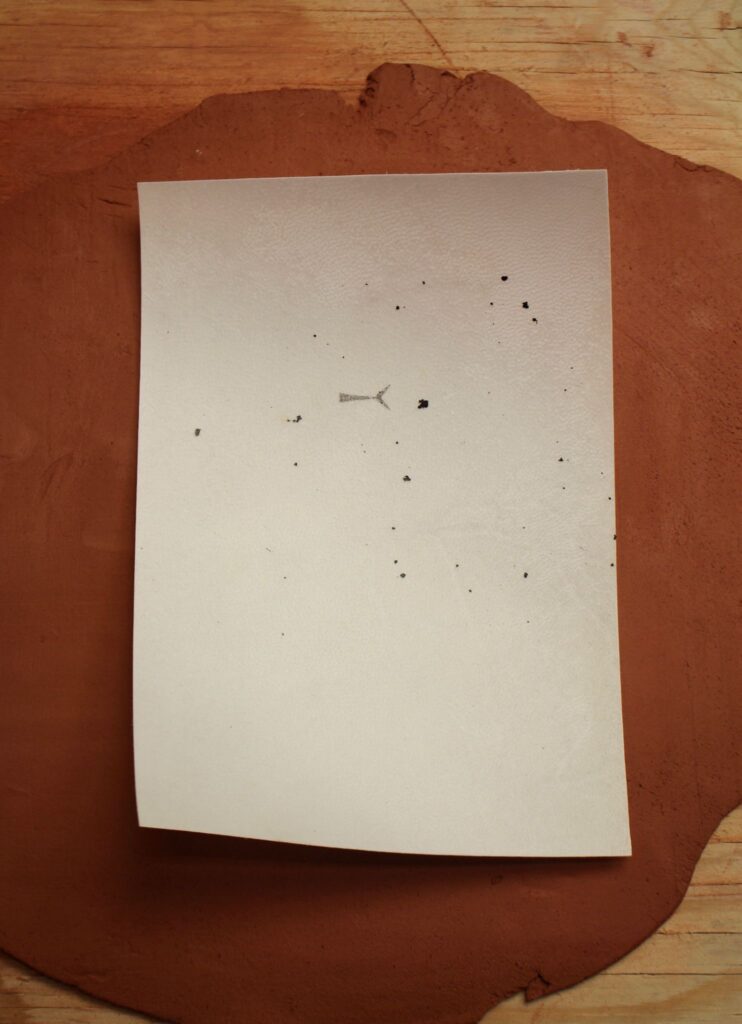
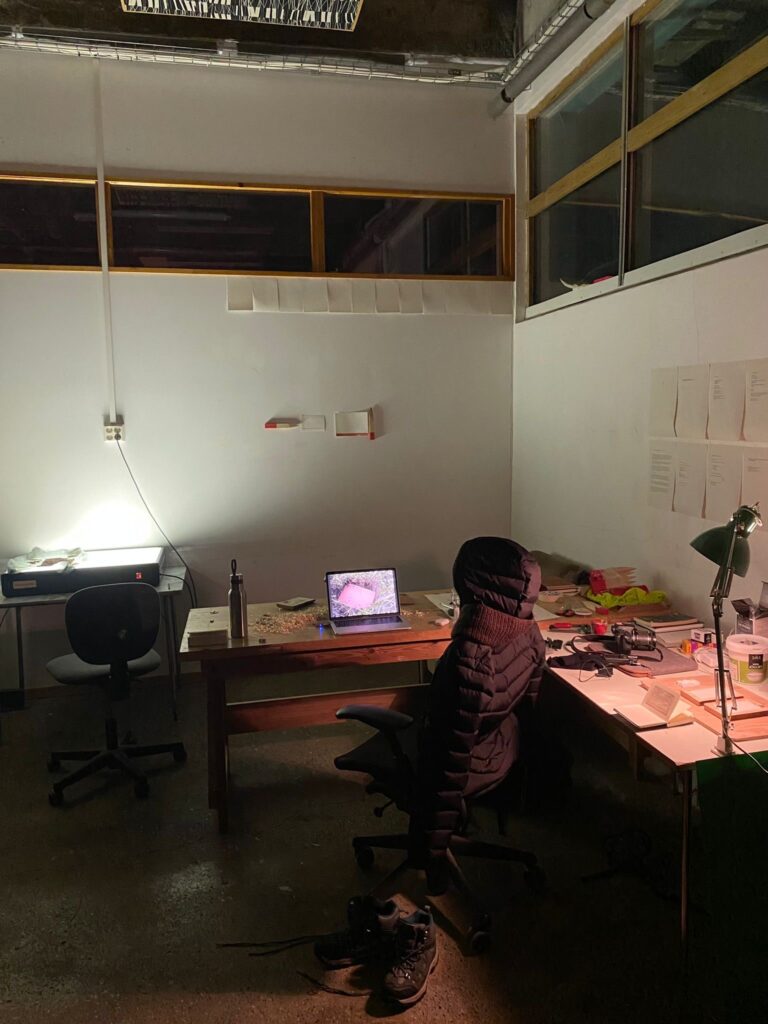
During the November residency, I produced a twelve part series of poetry and text segments containing ideas on geothermal energy, memory, histories of recording, subterranean incubation, burials, artefact, absence, futility and deep time. These texts were printed on vellum, wrapped in clay and buried around the village of Stöðvarfjörður at the start of the month. I then excavated the remaining eight pieces at the end of the month. The final text was also placed at the Mid-Atlantic ridge in between the North American and Eurasian tectonic plates in Thingvellir. Alongside this project, I produced a series of small pencil drawings and carved wooden replicas of Roman wax tablets.
I found great inspiration in the ‘Prose Edda’, bought an Ensk/Islensk dictionary and assumed the role of a tiny ant, wandering amongst the epic vastness of the Icelandic countryside.


Nick Wishart is an interdisciplinary artist and musician whose work merges sound, light, and movement. Using custom-built electronic instruments, sensors, and code, he creates immersive performances and installations that transform gesture and environment into audiovisual experiences. His practice explores the boundaries between technology, art, and play.


“I had an incredible time at the Fish Factory residency, where I focused on refining my live set and developing new ideas. A real highlight was performing at the Tiny Church in Stöðvarfjörður. I also captured extensive slow-motion and timelapse footage of the stunning East Icelandic landscape, which I’ve since woven into my audio reactive live visuals.
Thanks for all your hard work helping us with this project!”
Thank you, Nick!
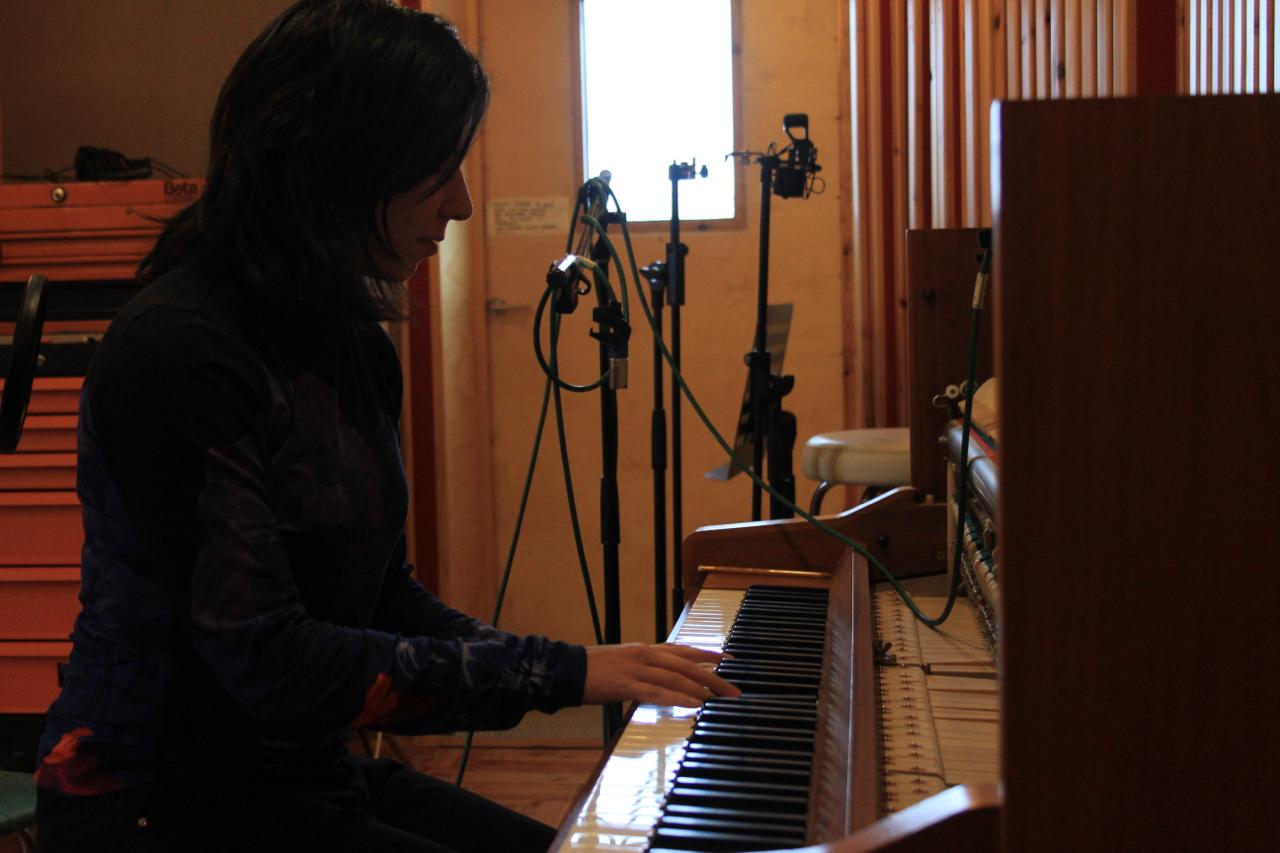
LeeAnn Perry (she/they) is a speculative fiction writer, electronic musician, generative audiovisual artist, and scientist based in San Francisco.

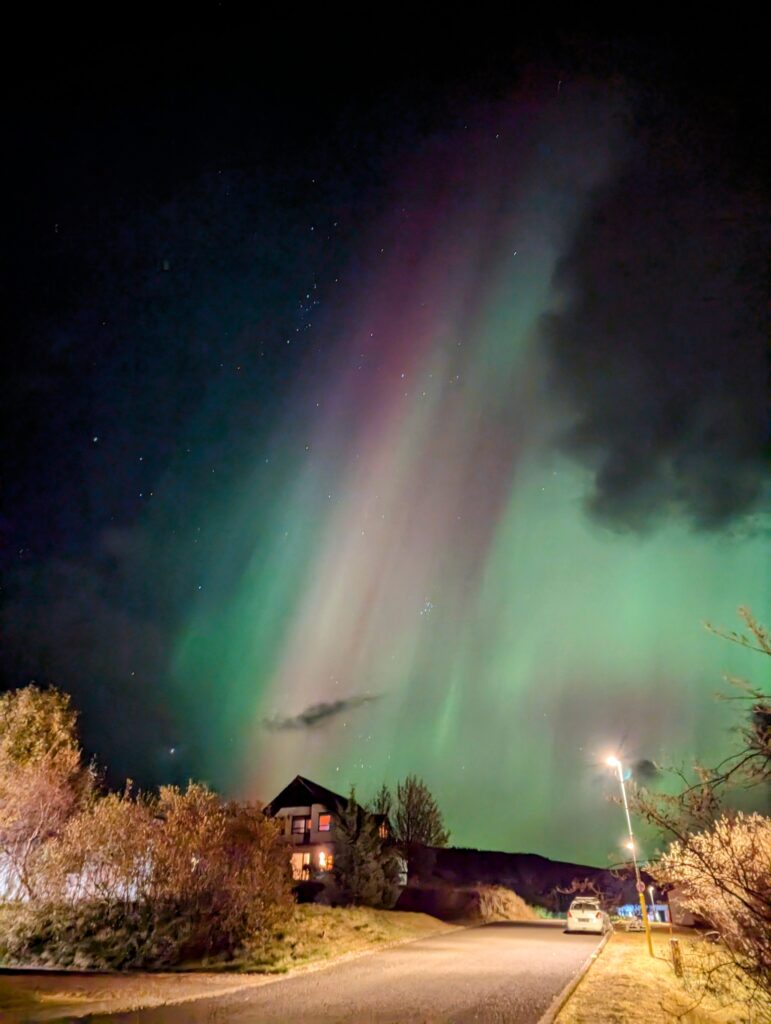
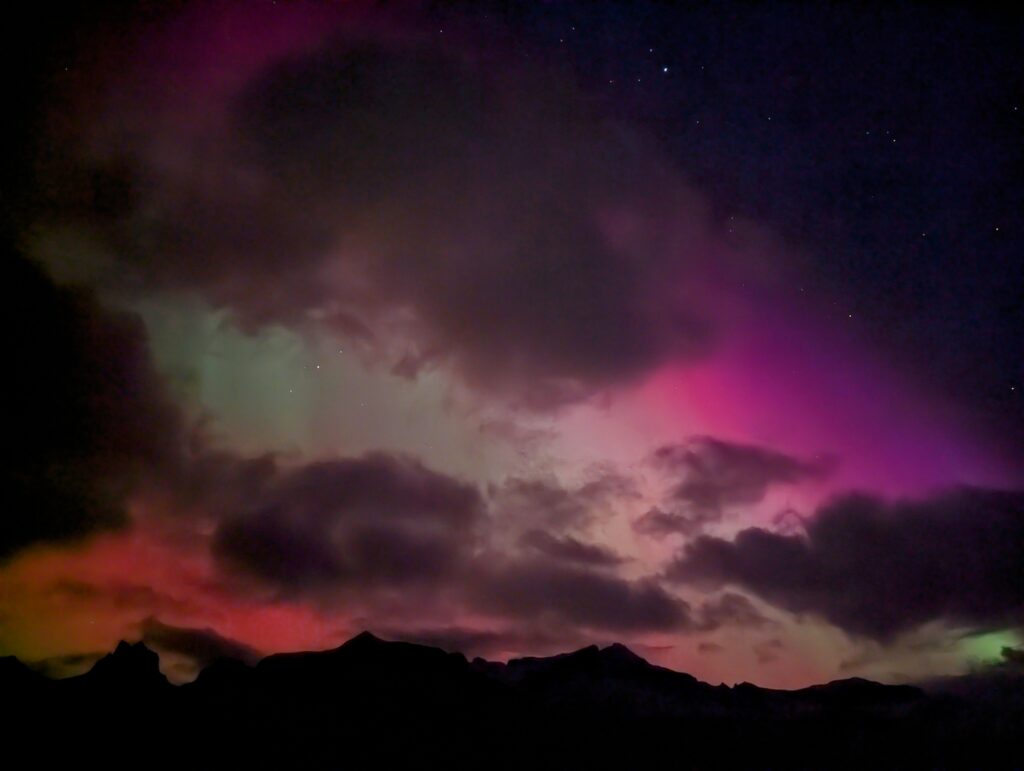
I initially came to the Fish Factory intending to work on fiction pieces, and as soon as I arrived I was inspired to experiment with form: I wrote a piece that took the form of a crossword puzzle, and another that took the form of notes on a mixtape.
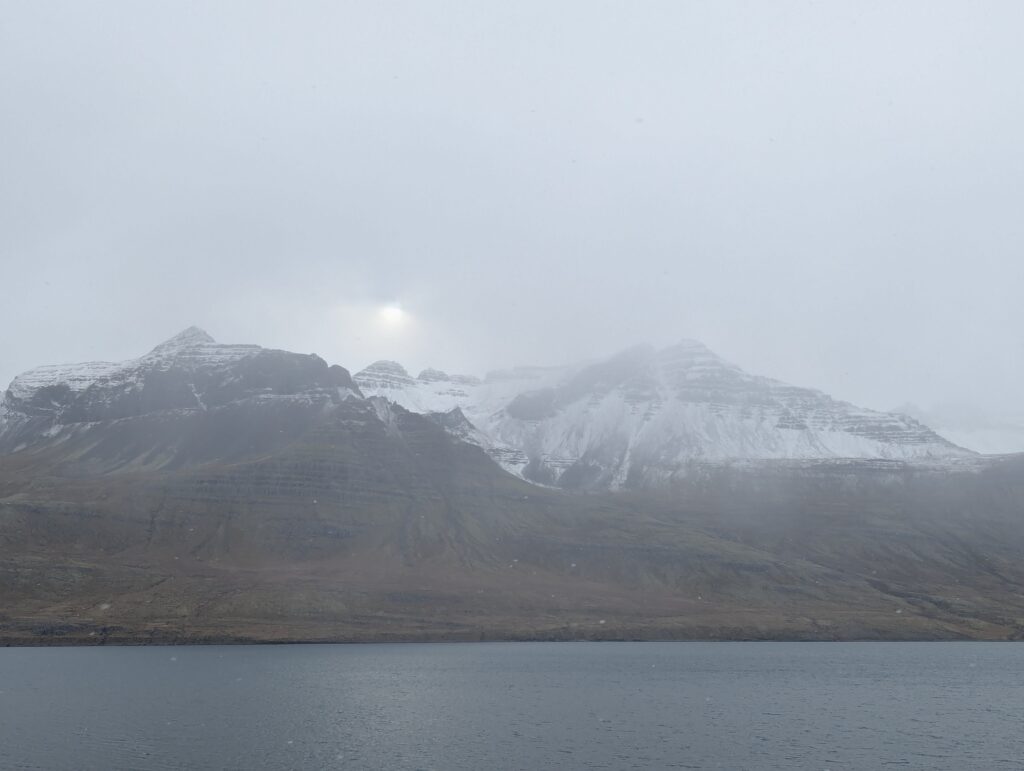
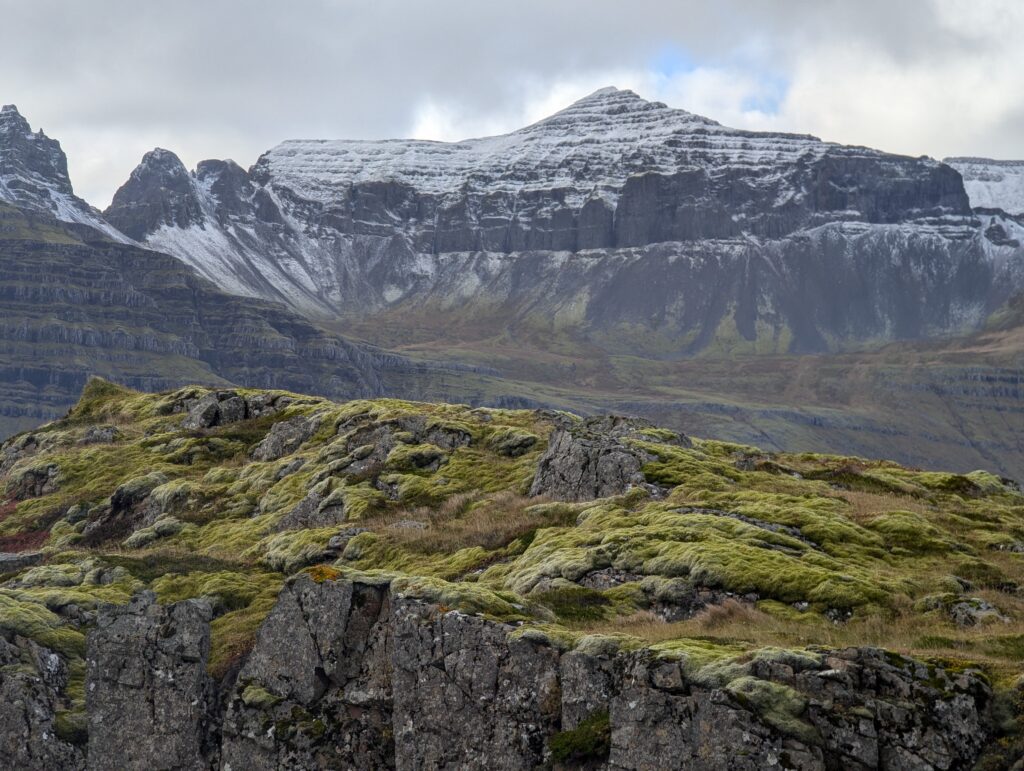
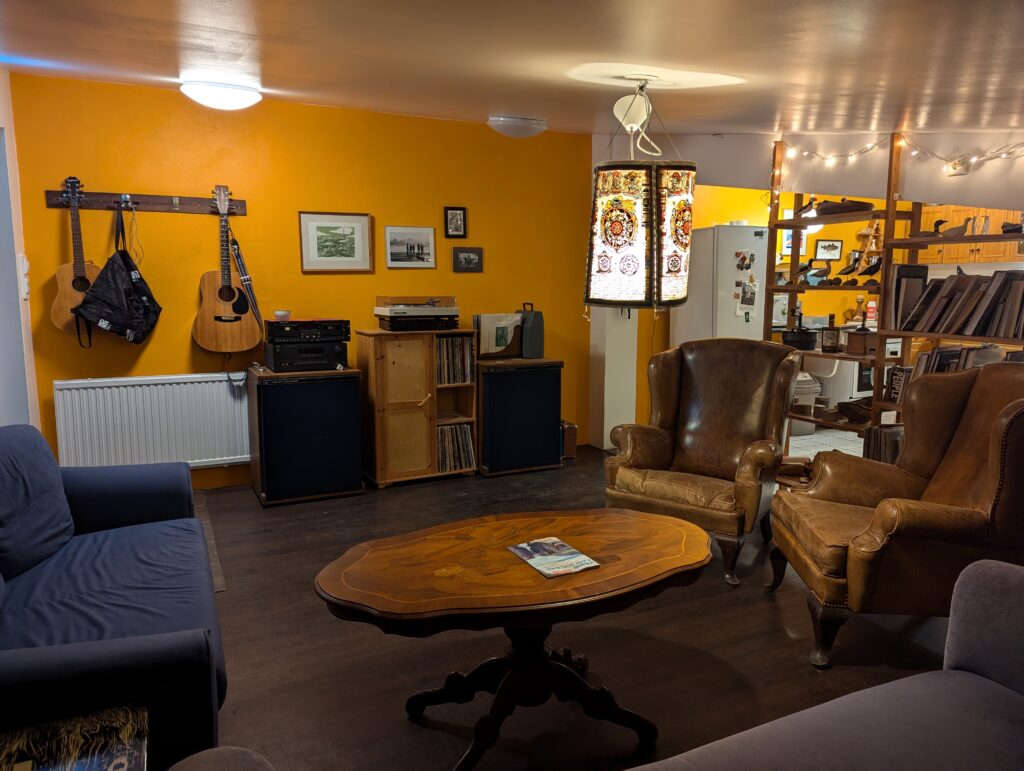
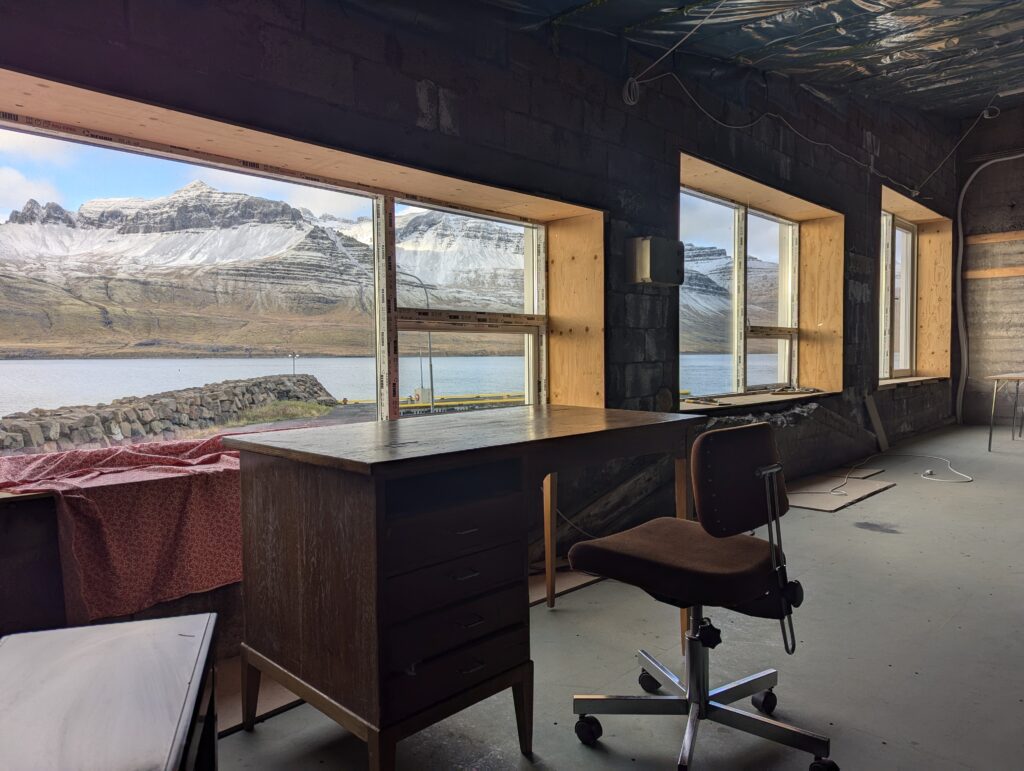
Soon, I realized I wanted to make something that was of this place and only of this place: of its grand peaks and aurora borealis, of its lichens and rocks and fjords. I started researching Icelandic history and folklore, a rabbit-hole that took me into news stories, academic journal articles in anthropology, the eddas and sagas, and personal accounts of encounters with the supernatural.
I became fascinated with the huldufólk, elven beings resembling humans but living in a parallel world, interwoven into the mythos of the land, and with the útburður, the ghosts of children who were abandoned to the elements. Reading deeper into these legends revealed a history of selective female infanticide, a topic that resonated emotionally for me due to its parallels in Chinese history. Soon I realized this was not meant to be a written story, but a series of intertwined songs. Fortunately for me, the Fish Factory has a recording studio complete with a beautiful piano.
Though I had worked with singers and songwriters before, I had never before written lyrics, or sang on a recording– my traditional domain was in the instrumentals, ambience, and production. I credit the exploratory and generative culture of the Fish Factory with giving me the courage to try writing and singing vocal parts for the first time.
In my songs, I imagine an alternate history where both the girls left to the elements and the mothers executed for infanticide were resurrected by the huldufólk with elemental rune magic and integrated into their world, and in turn lived to continue the cycle of salvation.
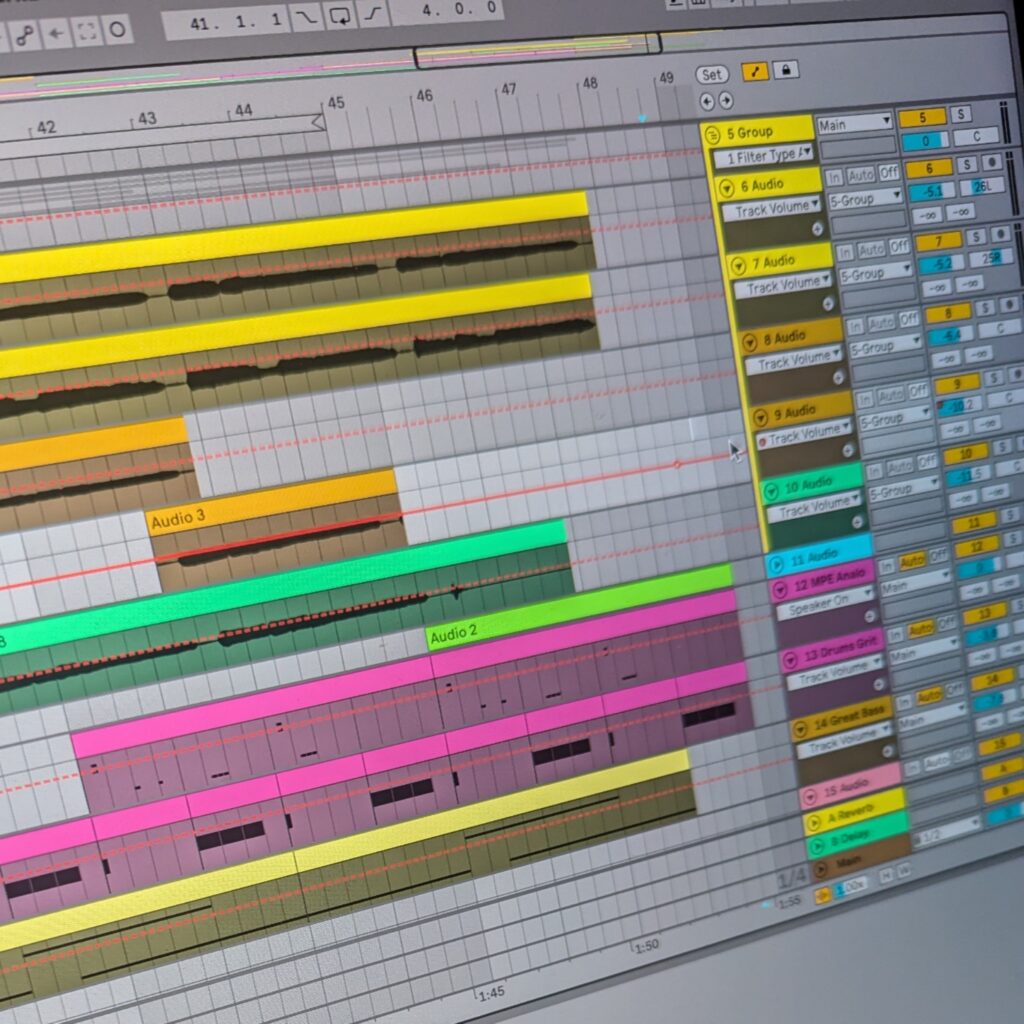


Musically, my pieces are built from layering dark drones, piano recordings manipulated with various effects, and vocals drenched in ethereal reverb. One of the tracks also features guest vocals by a fellow resident, @katebelanger, a testament to the collaborative and supportive nature of our tight-knit group of residents. I am currently mixing and mastering these songs, for release in 2025.
Many thanks to the Fish Factory for this wonderful opportunity to explore and express, and also to my cohort of residents, without whom I could not imagine this experience.


A huge thank you to everyone who joined us in 2024—it was such a bright and eventful year! Nearly 90 artists brought their creativity to Fish Factory, filling the year with inspiring art, music projects, and exhibitions. Without you, this place simply wouldn’t exist!
As we head into 2025, we’re excited to continue working on our space in the beautiful village of Stöðvarfjörður. We still have a few spots open for residencies from January to May 2025!
Residency spaces include access to ceramics facilities, a concert hall, a green room, and, hopefully soon, a new print workshop. Musicians—did you know releasing your work can qualify you for an Icelandic state refund?
Discover the quiet charm and natural beauty of East Iceland! :)
The residency fee is 150,000 ISK per month, including facilities, accommodation, and transport to and from Egilsstaðir.
Email us at contact@inhere.is or check the link in our bio for more details. And please share with anyone who might be interested!
Bear with us during our winter break—we’ll be back in January to answer emails. :)
Fish Factory Team – Una, Vinny, Kris, Lucas, Tummi and Miso.
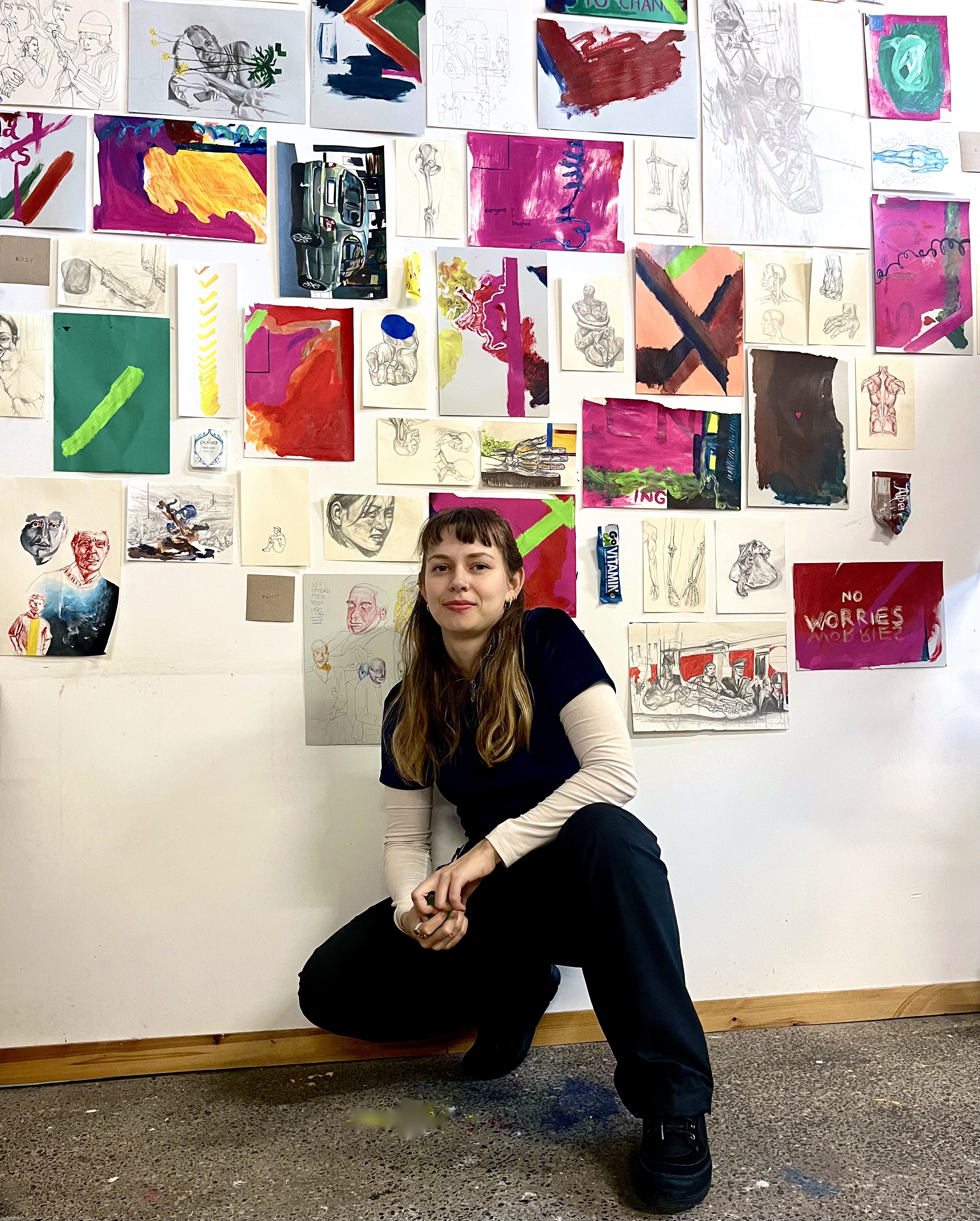
Camilla (she/they) is a Naarm-based multidisciplinary artist, sustainability advocate and learning designer.
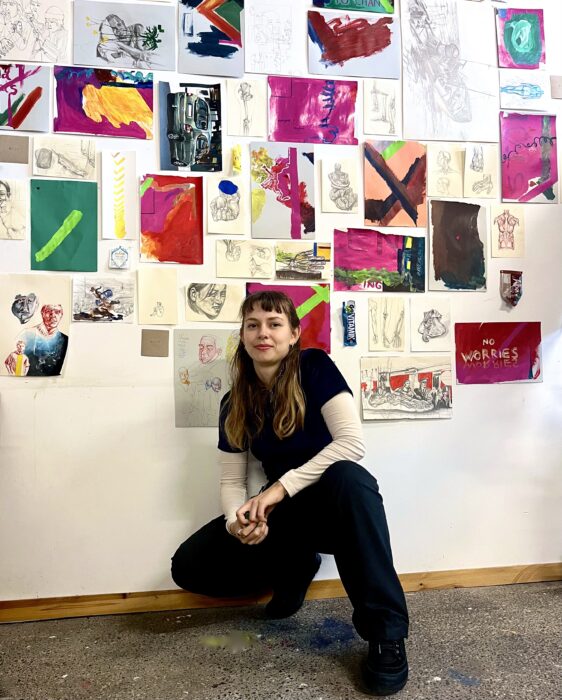
She has exhibited in multiple spaces including NOIR Darkroom, Counihan Gallery, Schoolhouse Studios, Platform Arts Geelong and Honey Bones Gallery. She is halfway through a Master of Fine Art at RMIT University. Camilla also has experience teaching art and painting murals. In 2024, Camilla completed two artist residencies, one in Estonia and one in Iceland. Thematically, their work sits in the nexus of climate change, mental health, and corporate culture. Formally, Camilla is interested in different ways of framing experience through illustration, collage and digital aesthetics.

THIS RESIDENCY
I have explored compositional space. I have explored absence and presence on the page and at large. I have gone through the motions of a process. I have engaged with flow and with experimentation and with not caring what comes out. I have played with intense technical rendering and then free, sloppy, mark-making – and have experimented with putting them both together. Constraint and catharsis. Through this, I’ve inadvertently explored emotional processing and what it looks like through art. I have made according to my value of using whatever you have and whatever is around you, and by doing so, have embraced chance and spontaneity.
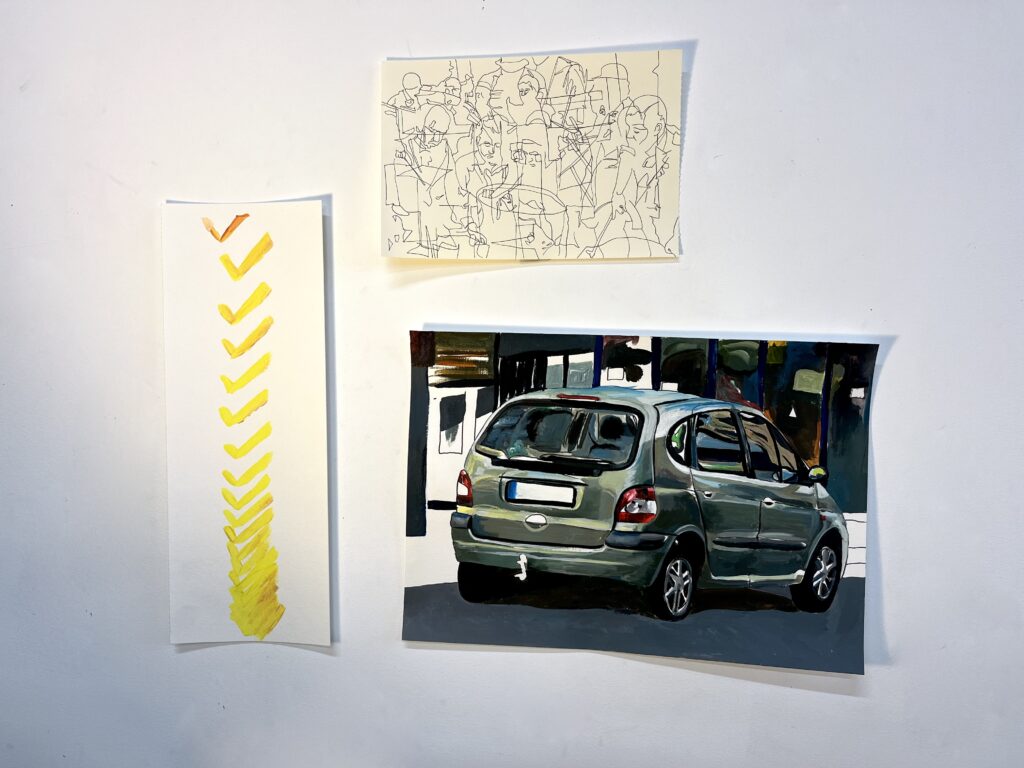
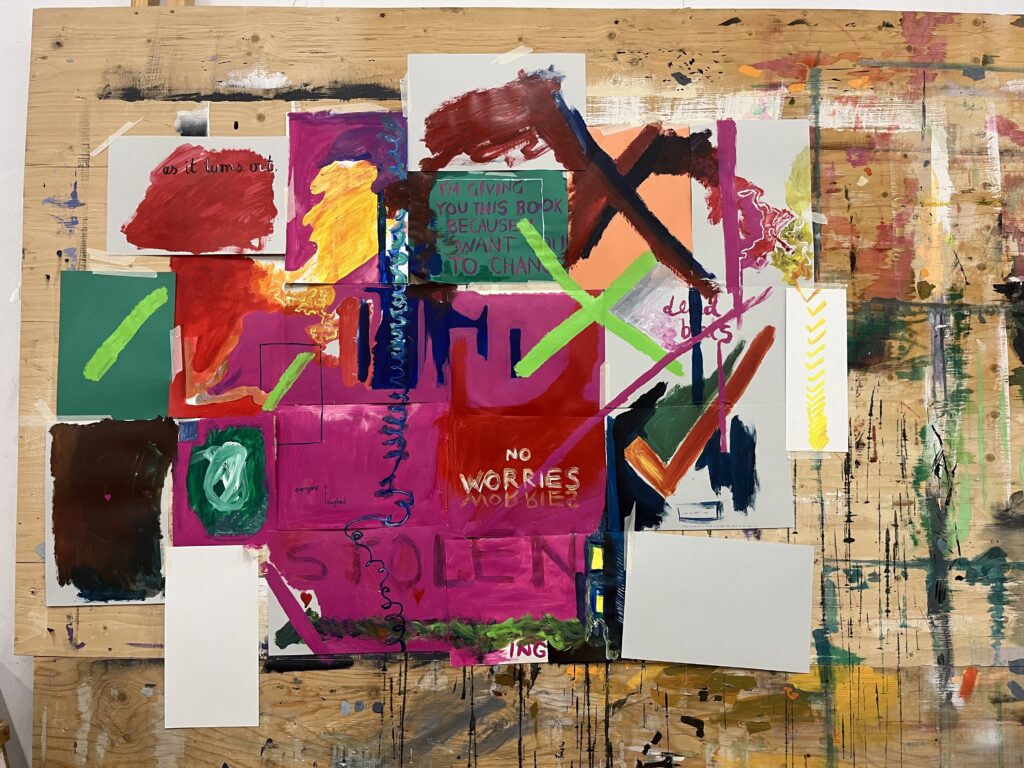
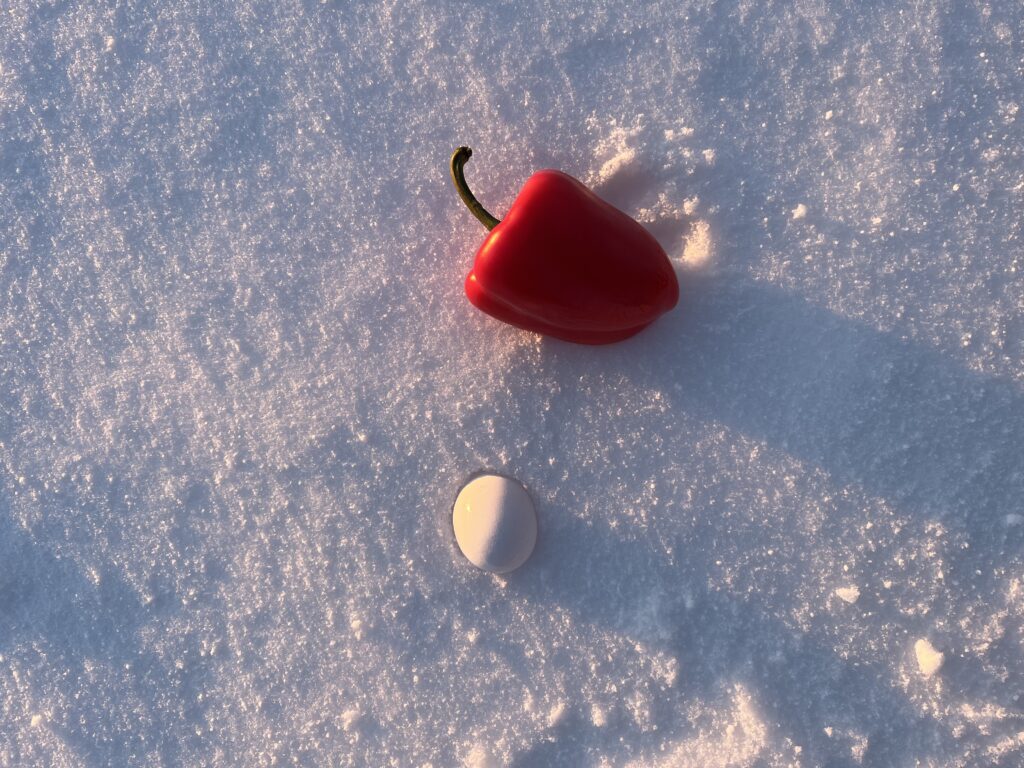

I have drawn from life, both macro and micro. I have drawn from books, magazines and photos. I have inadvertently explored repetition. I have yet again been drawn to collage. I have frozen, been frozen, and defrosted. I have embraced free association and absurdism through words and tacit means. I have reflected my surroundings and my inner landscape too. I have admitted that illustration is important to me. and that it is a style that I can’t help but carry with me. I have been angry and I have been thoughtful I have critiqued certain people and parts of society at large. The phrase ‘at large’ has been echoing around my head. I have been accepting my head. I have expressed deep cynicism, frustration and perhaps a kind of unravelling. I have worn the same ski boots every day. I mean snowshoes. I am new to such a chilly lexicon. I have drunk a lot of coffee made by different people and different methods. I have thought about outsiders, about oppression, about the representation of the world. I have been amazed by how much effort it takes to draw a single stone. I have concentrated, and thus, been free.
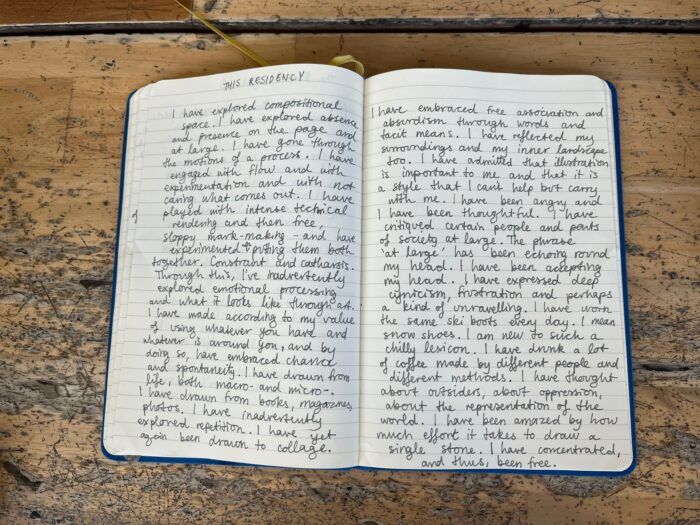
Website: https://camillaeustance.com/
Instagram: https://www.instagram.com/camillaeustance__/
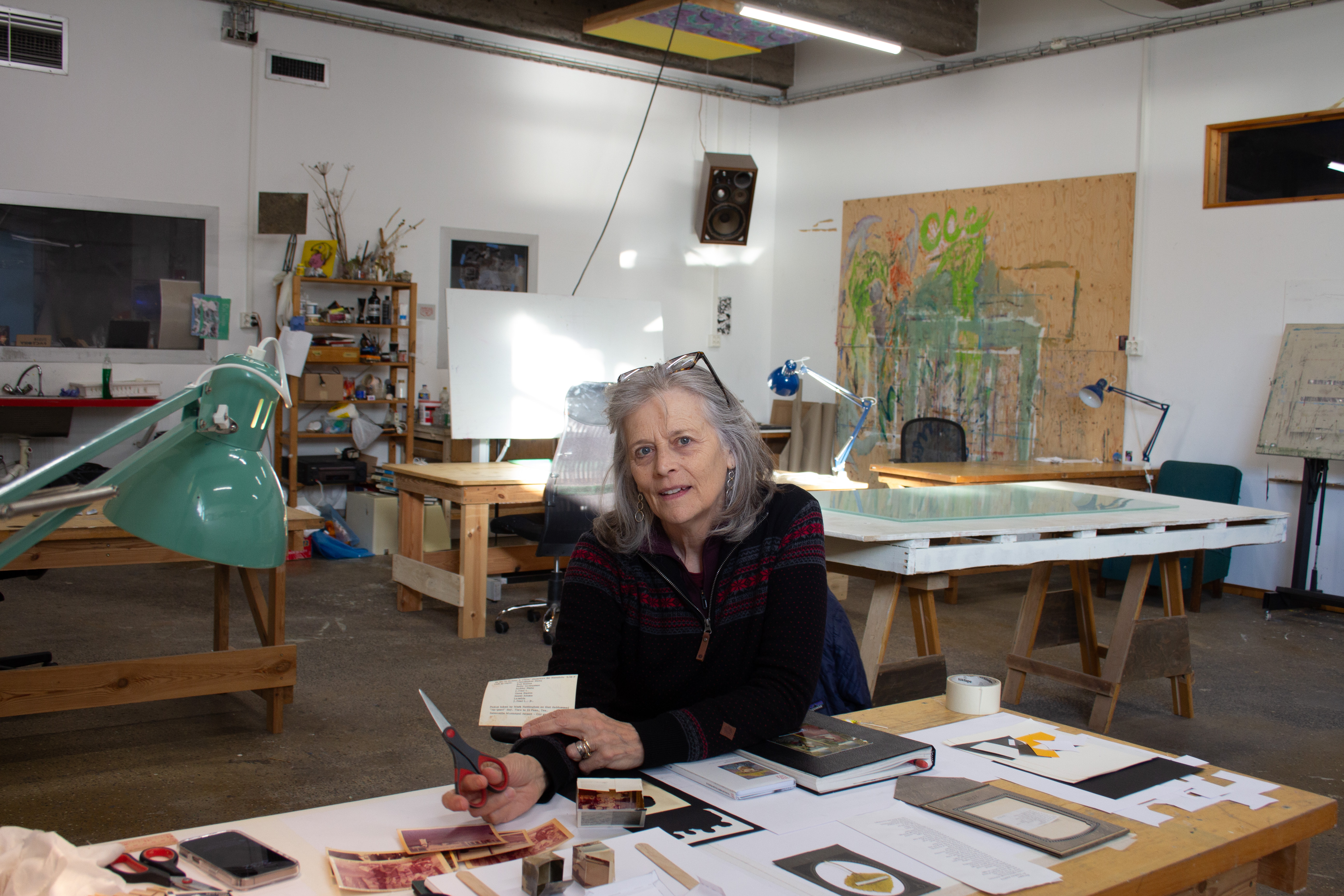
Elizabeth Evans is a multidisciplinary artist from California, US.
The Fish Factory Artists Residency gave me the time and space to pursue artistic projects and questions that are important to me. I came to Iceland as a 2-dimensional collage artist but being in the center’s spaces with other artists engendered new directions in my thinking and I found my work evolving in interesting new directions. My 2-dimensional work blossomed into 3-dimensional boxes and coffins made of old photographs.
I also created a mock up for an installation I am interested in creating to full scale. That piece would involve a 6’x 6’ cube made of PVC with rows of paper chains hanging from PVC bars across the top of the cube like rows of paper curtains. The first row would consist of a paper silhouette of my step-father and me in an awkward dance. Each preceding row would show an increasingly abstract form representing the deterioration and change of psychic injuries over time. The final row would hold diaphanous shredded paper.
While here I also began to explore ideas of obscuring and hiding information in 2-dimensional collage using cross-hatching, silhouettes and cut outs. Creative conversations with other residents were inspiring and interesting and were an important part of the evolution of my thinking. I’m eager to explore these new ideas and paths that this experience has engendered.
Thank you to the Fish Factory staff for making this time so memorable.
Instagram: https://www.instagram.com/elizabword/
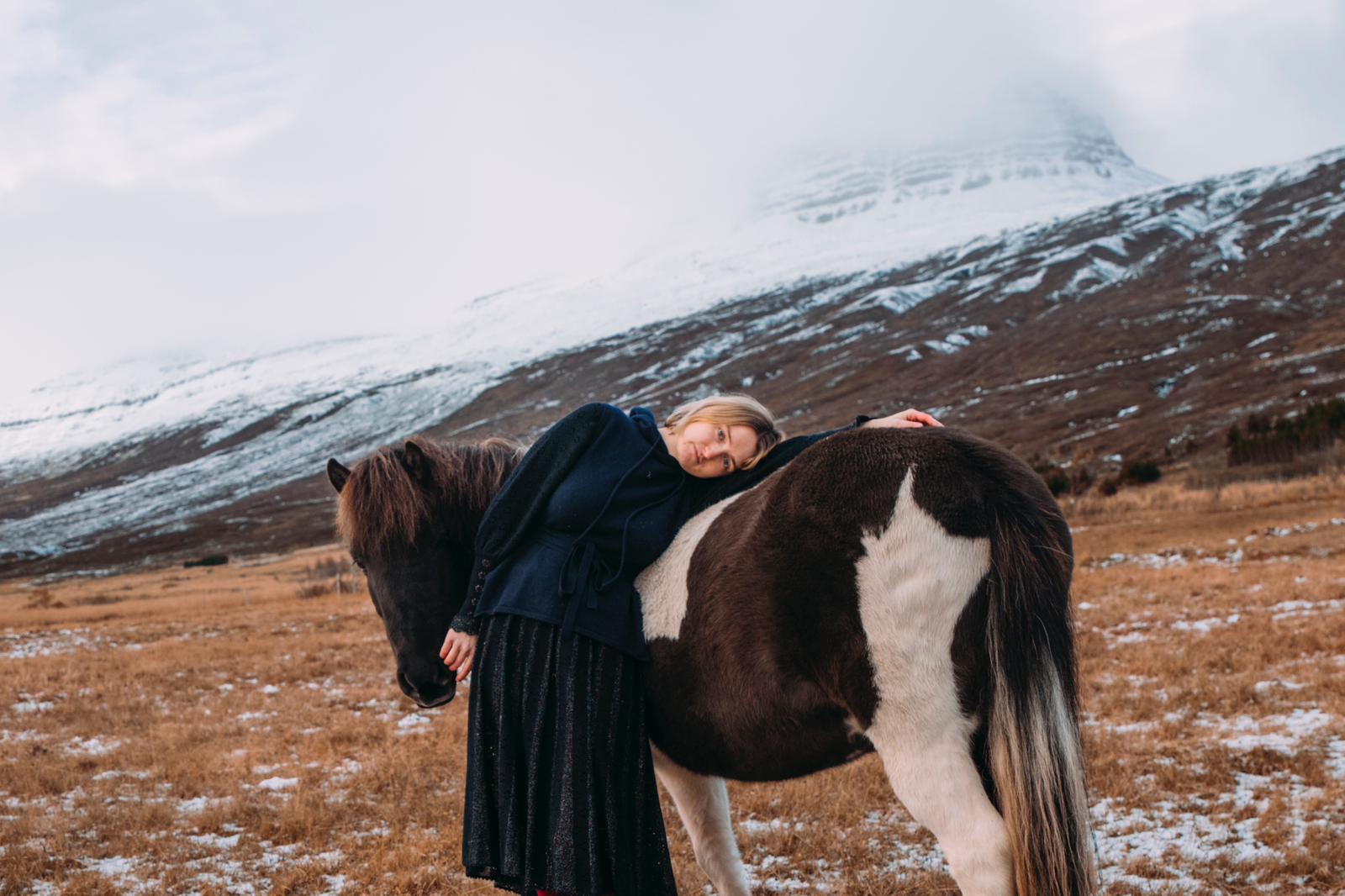
Nancy Pilkington is an artist from Stanstead Abbotts, UK.
During my stay at the fish factory I had a unique opportunity to gather myself creatively. I enjoyed testing the limits of my practice, learning a new skill and taking up an old one. I began working with clay which helped build my intuition. As I got comfortable, the pieces got smaller, finishing with a castle the size of my thumb.
Gradually I moved towards drawing and paint. The restriction of scale allowed more freedom to build layers. I collated my favourite painters, names of stones and ideas, fossilising.
I am very grateful for the time I spent in Stöðvarfjörður. The camaraderie of the group and the epic beauty of the Fjord provided me with a rich resource I will carry on my journey forward.
Website: https://nancypilkington.uk/
Instagram: https://www.instagram.com/nancypilk/
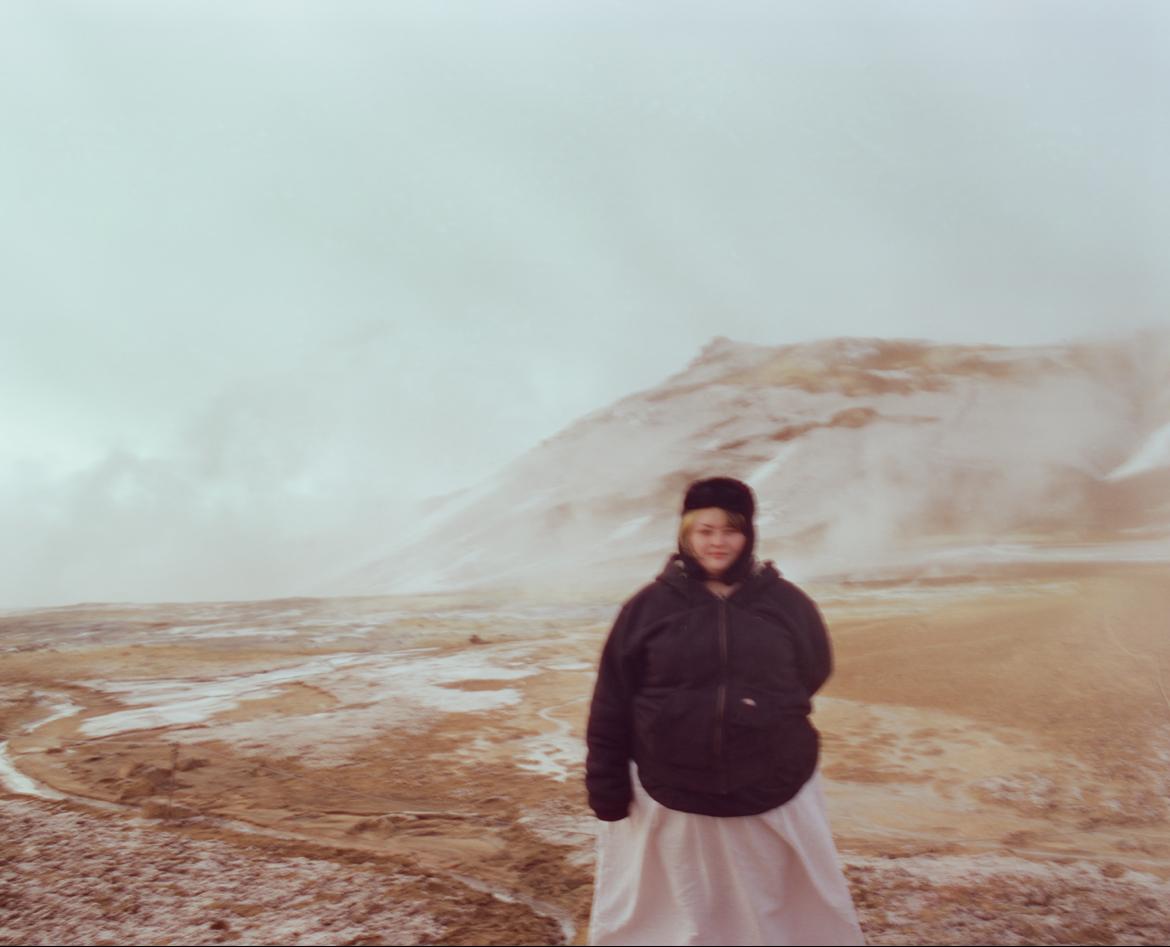
Caroline Galderisi is a multimedia artist and photographer from Brooklyn, NY.

Through layering and collage Caroline will continue this project back in NYC’s coastal areas to print cyanotypes on different objects such as driftwood and shipping containers.
Website: https://galderisi.space/
Instagram: https://www.instagram.com/carolinegalderisi

Bailey Sherwood is an oil painter who resides in Newberg, Oregon.
Over the last several years I have done work that engages in the interplay between the natural and the unnatural by incorporating stage pieces placed in natural environments.
During my stay at the Fish Factory residency, I was interested in horror and sci-fi texts where the grotesque, the strange, and the alien serve as placeholders for marginal identities, revealing culture’s collective fears and hysteria. I created paintings incorporating a flesh-like figure, warped into an alien form, interacting with the natural landscape. There is a fluidity to the objects that invoke familiar and yet strange images of the flesh. This fluidity, in relationship with nature, serves to challenge the notions of what is natural.
I am very thankful for my time at the Fish Factory and my ability to take advantage of this beautiful surrealist environment around the village of Stöðvarfjörður, creating reference images during my frequent hikes in the area.
Website: https://www.baileysherwood.com/
Instagram: https://www.instagram.com/_scout_b

Cula Bula – Mixed Media Artist from Ireland
I made my second visit to the Fish Factory this year, to honour some time out for my self. I had been working on getting my health on track and hoped to ease myself back into creativity after such a long break.
I wondered around the landscape just to observe and breathe it in. Autumn being my favourite season I found myself collecting the decaying leaves and flowers as they fell to earth through their process of seasonal change.
After such a long time I felt like I’d literally forgotten how to paint. When I felt ready I would sit in the studio and just look at all the things I had collected. I did this for long enough to want to pick up a pen. Then a paintbrush. In the end I loved playing with a geli plate as it was a new experience for me, it felt free and non-restrictive.
Retreating back into stillness and clarity and witnessing the rapid shifting landscape was just the most perfect reflection of my physical and mental state and one of the best things I ever did. I miss all of the people I shared this experience with. I can never imagine feeling finished with this place.
Instagram: https://www.instagram.com/cula.bula.art/
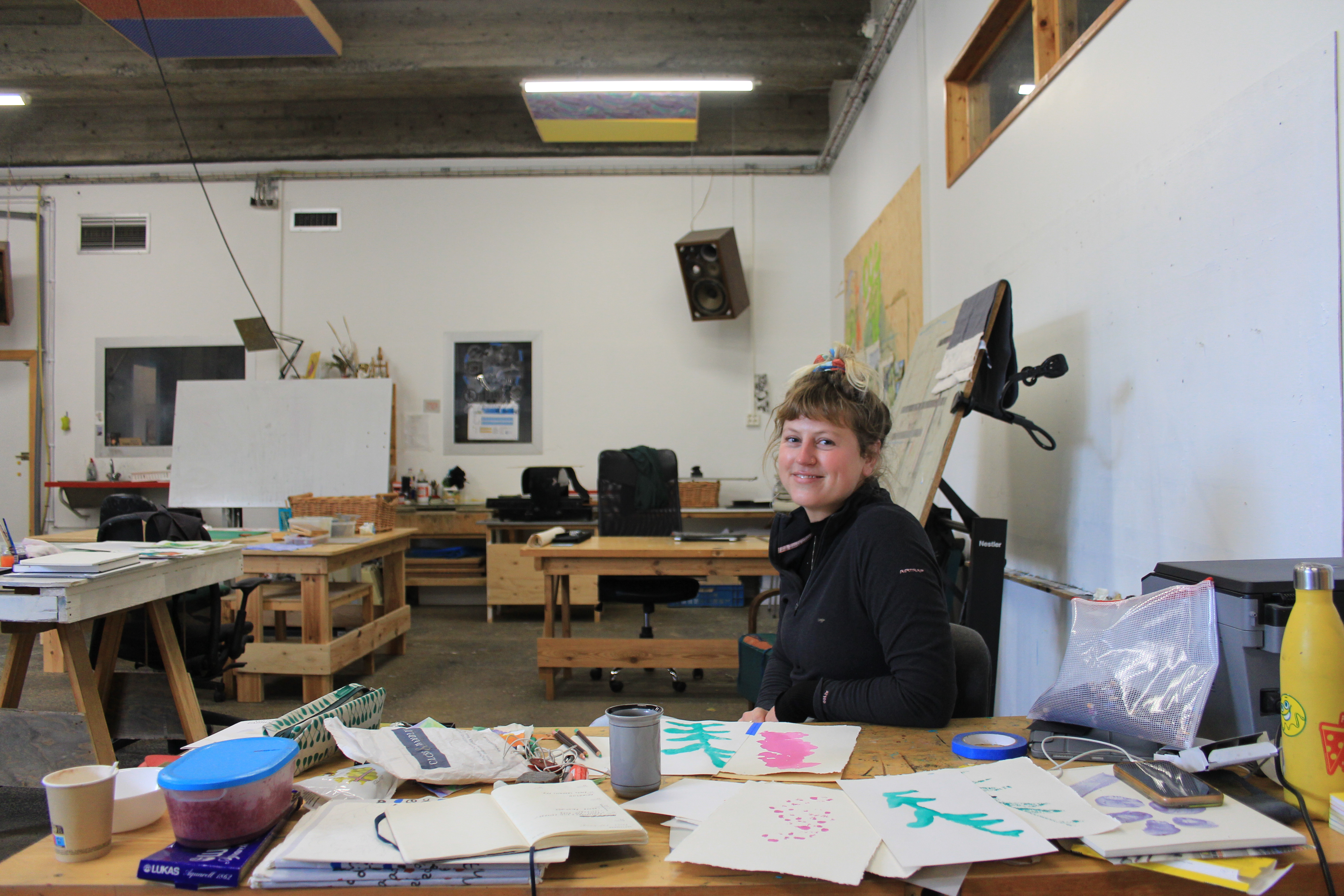
Lucy Sherston – an artist and illustrator living on the South Coast of the UK.
My work often takes the form of digital collage, where I scan in hand painted elements and layer them together digitally. I think of my work as little fragments of a patchwork, that when pieced together build up a sense of a place or a feeling.
Before I began the residency at the Fish Factory I had an idea of what I wanted to work on but I quickly realised that for me, it felt more important to loosen up and just play without a specific end goal.
This freedom and time allowed me to discover new ways of working that I feel really excited to continue exploring. I also had the opportunity to collaborate with Harry and Nicholas, 2 musicians on the residency at the same time as me. Working on some album artwork for a record they’d made was such a spontaneous and joyful experience. I’m also incredibly grateful to have had the opportunity to experiment with ceramics for the first time, thanks to fellow resident Arista. These ceramics turned out to be some of my favourite things I made during the residency, which was a total surprise to me!
I felt such a sense of peace during my time at The Fish Factory, walking in the mountains with Tumi and watching the colours change with the season. It made me realise a lot about myself and the pace of life I want to try to live going forward.
Instagram: https://www.instagram.com/lucysherston/
Linktree: https://linktr.ee/lucysherston

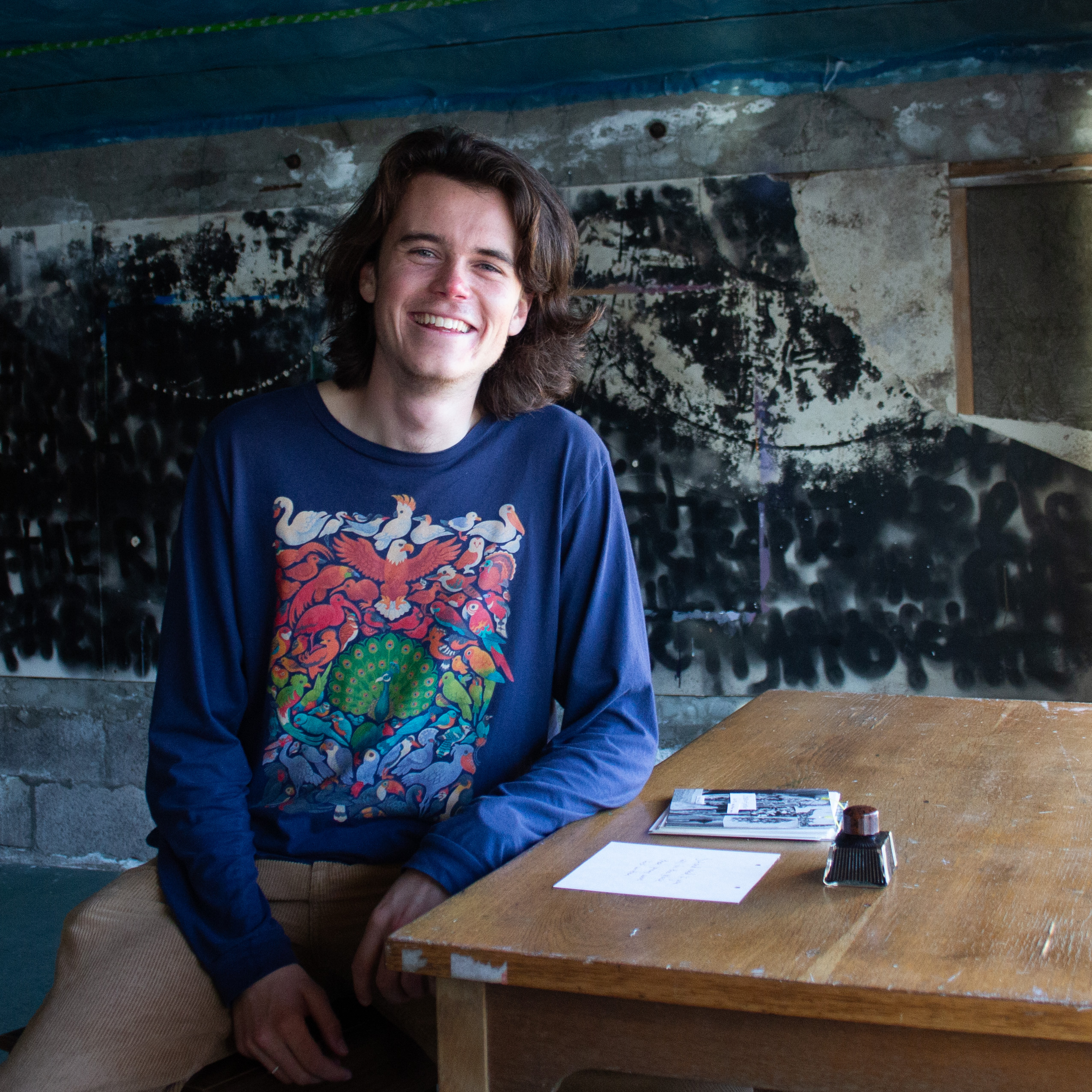
Riley Faulds is an environmental scientist in the streets, and a poet in the sheets. Originally from Whadjuk, Bindjareb and Wadandi Noongar Country on the west coast of Australia, he’s currently studying his doctorate in World Literatures at the University of Oxford. His thesis focuses on how the contrasting systems of colonial expansion in Australia, southern Africa and the Caribbean have influenced literatures of agriculture and gardening in those zones.
His poems and reviews have been published in various of Australia’s best journals and magazines, including Westerly, Rabbit, Cordite, Plumwood Mountain and the Australian Poetry Anthology, though he saves his best work for birthday cards. In the past year, he was Highly Commended in the Bruce Dawe National Poetry Prize and won the Jon Stallworthy Poetry Prize. Before moving to sunny England for his Masters and DPhil, Riley worked as an enviro scientist and studied Agricultural Science and English & Cultural Studies at the University of Western Australia, with Honours in Creative Writing. He’s obsessed with weeds.
***
And weeds are what I started my Fish Factory Residency with in August. I first came across the Residency a few years ago in some newsletter or other, and dreamed of flying up one day to the country that’s been at the top of my list to visit for a long time. Arriving to study in England meant the only barrier left was the North Sea, and ford that I did (with the help of Icelandair), after long months of writing a Masters dissertation on weeds in Australian poetry.
The cloud was low and the fog thick when I first touched down in Egilsstaðir enroute Stöðvarfjörður, but I quickly found some fellow Factory-bound artists and knew I was in for a beautiful time. We were greeted by the amazing Kris, Vinny, Tumi and Miso, and by the spectacular views of the fjord and mountains from the Factory. My first poem was about the vibrant flowers of the Nootka Lupin (a proscribed invasive weed) in the carpark of the Factory, and from there I bounced between full days of furious writing, and periods where words wouldn’t come. Those days were for exploring, chatting with my fellow-travellers and chuckin’ a stick for Tumi, and hiking and camping in the mountains, where I saw some beautiful and some spooky things.
I ended up writing a lot over the course of the month, though I could definitely have written more. I waxed lyrical about the fjord and beyond, about the home I miss so much, and worked on a verse novella of sorts, a murder mystery outside the bounds of what I usually write. I started a blog (hilarious, classic), compiled a manuscript of poems, found clarity here and there, and revelled in the Friday night group dinners with my lovely co-Residents, the trip to the next fjord for a punk and metal gig, and spotted whales, seals and birds of all kinds. I even did some visual art myself (far outside my usual wheelhouse!), making a collage-covered book of poems I’d written during the month, illustrated by the amazing Olwyn. The final exhibition/concert I put it together for was world-class.
The dynamic, unfamiliar ecologies, amazing collaborative space and group, and support from Kris and Vinny have propelled me into a new stage of writing and getting my words out there. I spent an amazing month here, and got to drive and camp around the island afterwards—what an incredible place! But I’ve got a few more Stöðvarfjörður poems knocking around my brain, so I have some unfinished business in the fjord. Plus, I need to see those lupins flower again, and witness how much more real estate they manage to claim, so I’ll definitely be back—that’s a threat…
Stöðvarfjörður Suite
1. what a boat becomes
there is a place at the mouth of the fjord
on which the ocean’s rush breaks open
twice, three times, as i watch what should be
open water. a reef there, i guess, at what
i thought was a boat, at first, tracing
subsurface waves below the wash of
the audible. but i watch the place, two
three times soon after, and no rockswirled white
is shown. a boat that was a reef must
in fact be a whale, spuming launching
and quieting away to some other open place.
2. water fall
surely a day’s flow down green mountain
would be enough to drain that one steepness.
ankle-deep moss and rock is all there is
upon that face—no glacier/snowmelt.
time and sun must surely put all streams
to rest. but step rather than see, and
you’ll know that moss has its infinite pores
that the sound of water in marble halls
is everywhere underfoot up there, that
only constant racing or glacial-paced cold
could make a place like this
3. construction site
as if the siltsmudge below the diggers quarrying sea wall,
spreading shadowbrown along the villageside edge
mocks blue, and replaces the glaciers that formed it
with a far sharper sound than a proper deep creaking.
4. the birds
last night, frank watched The Birds, and hitchcock
spoke, in a way, through tiny signs in the house
this morning. fingernailsize droppings, a tear
in a leather arm, and no bird found bodily. except
the brittle raven, stood ceramic above
the half-locked cabinet, the window cracked.
at night, seabirds gather in the pools of light cast
by the dock’s many floods, dipping necks into places
only they, and magnetic fish forced to that glow
can see. they aren’t the same daybirds that fan together,
arrayed against fjord’s inward swell-lines
making slow way towards the mouth
ripples streaming aside as if they were still rocks
in a rapid. ducks, or some other dark bird, tracing
with their communal body where currents strike tides
meet waves—where fjord must catch and eddy
in the clouded day darker than deep flood light.
5. nootka lupin
one of only three proscribed invasives on this whole invaded land
purple flowers resist their turn to greyed seedpods, scattered profuse
all around this factory, this centre of a brief bevelled life. so many species
are beyond the native, in the two kinds of here that are this island
and this carpark. and yet, this only weed loops nitrogen in the cracks
between oily carwrecks rusting into the fjord, around trucks speeding nightly
through sleeping village above ninth-century longhouse, far below
fogged lakes clearing sudden to the half-rot tortured corpse
of a reindeer strapped to imported wood. no weeds in sight, except
for every non-mossy species. no weeds in sight, but
the one we should all agree on.

Arista is an artist from Virginia, United States. Arista spent the month of September teaching a crash course ceramic intensive to community members from nearby fjords and international artists in residence! Outside of teaching, Arista spent time painting grass, picking blueberries, and making dumplings.
Some thoughts on grass:
“Grass is green, grass is good. Golden strands stripe their way across green moss or peel out of blue snow. Grass can be one thing or many, a single line or a field of color. Grass stands strong atop the grandest mountains, and it billows gently around our homes, on roadsides and farm fields. Grass feels like comfort, found in all places. I spent two months in Iceland this year, and in that time I observed grass in many stages. Even in the most alien landscapes I found my old friend grass peeking through.
In my paintings, I’m interested in the feeling a landscape and the way a feeling can be built out of pattern, color, and line. I love the compositions found in a patch of foliage and the emerging layers of light. I’m curious about how a landscape can be abstracted, but the feeling can remain literal: sometimes pastoral, sometimes warm, sometimes joyous, sometimes melancholy, sometimes a feeling you remember but can’t quite name. Throughout all those feelings I find grass and I am moved by it’s sway.”
Website: https://aristawilson.com/
Profile from April 2024: https://inhere.is/2024/05/arista-wilson/
Instagram: https://www.instagram.com/arista.wilson/
╰( ⊹o⊹)╮
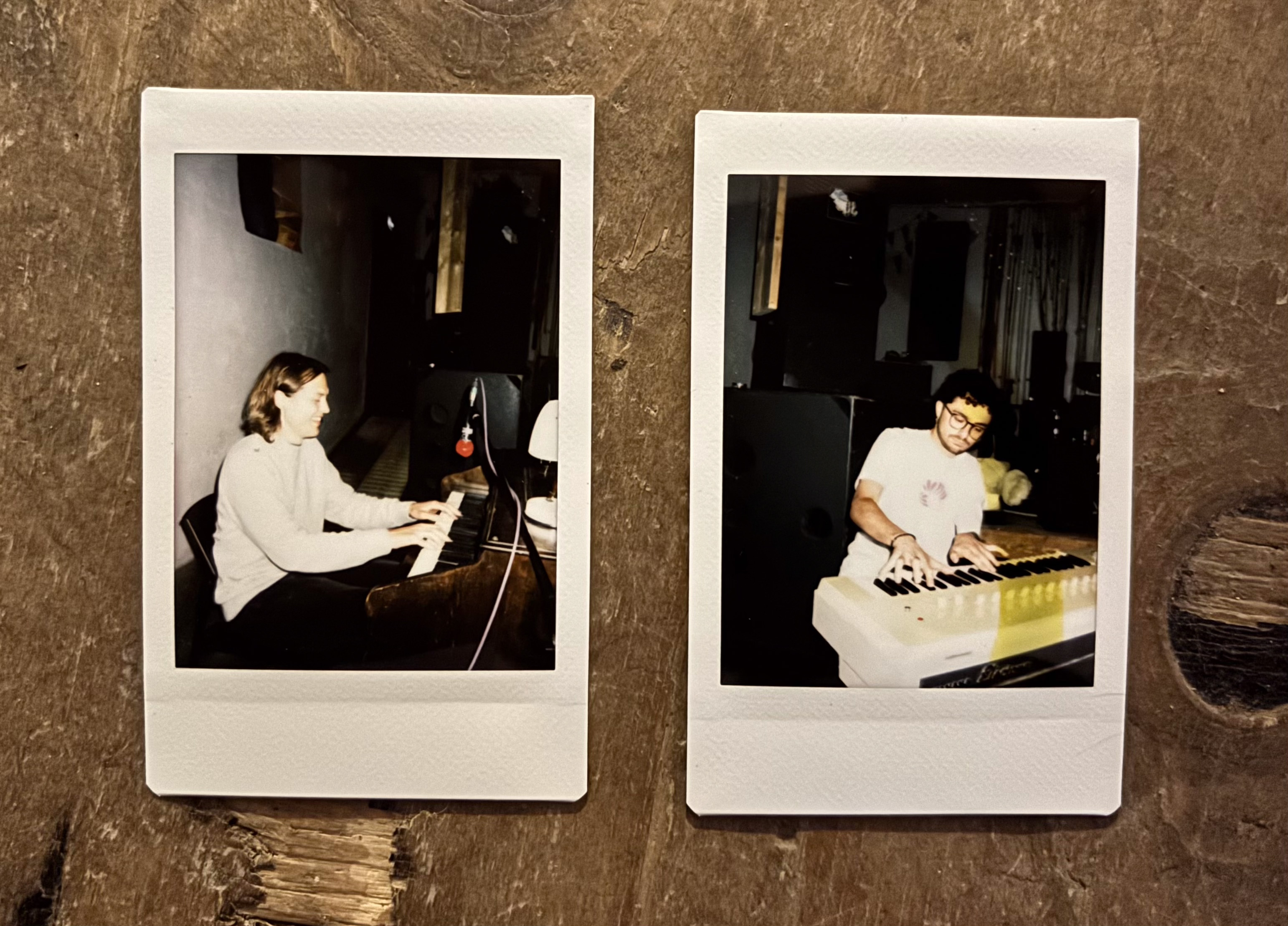
Nicholas Miller is a composer, improviser, guitarist, and multidisciplinary artist. Their work is informed by jazz, magic, ecology, and performance art. They have performed internationally and collaborated with a huge variety of musicians and other artists. They hold degrees in jazz, guitar performance, and composition from the University of Denver, Utah State, and Oxford.
Harry O’Connor is an Irish composer and violinist. Harry’s own compositional practice is currently based around soundtracking nature and landscape, focusing within the idiom of jazz-inflected chamber and orchestral music. As a violinist, Harry has been involved with various groups and performers across many styles, ranging from historical performance practice to contemporary and avant-garde music. Harry graduated from the MTU Cork School of Music in 2021 with a BMus (Hons) degree. In September 2024, he graduated with an MSt in Music (Composition) from the University of Oxford.
When they arrived at the Fish Factory, both Harry and Nicholas were intrigued by the array of different instruments lying around the building, particularly the many electronic organs and keyboard synthesisers. Between them, a concept developed of using as many of these organs and keyboards as possible for the sake of a recording project, based around free improvisation. Over a period of roughly seven days, Harry and Nicholas produced a varied series of recorded improvisations utilising as many instrumental combinations as possible.
These recordings were catalogued, edited together, and used as the source material for a 40-minute vinyl LP album entitled GILDIA ORGANORUM HYPERBOREA. The LP, of which ten copies were cut at the Fish Factory, brings together just some of the improvised material across two 20-minute tracks. They also produced a series of ten cassettes under the same name, across which the near-total 3.5 hours worth of recordings are collected, with each cassette being a completely unique combination of recordings.
Having access to such a bizarre assortment of instruments was an exciting opportunity for combining play and technology. Along with the improvised musical material, the LP also features overlaid software instruments, recorded water sounds from the harbour in Stöðvarfjörður, as well as sound from the banging door of Iceland’s most northerly lighthouse in Hraufnhafnartangi.
Harry and Nicholas completed their residency period with a live performance showcasing the different instruments they used at the Fish Factory. Stöðvarfjörður provided the perfect setting for their project, and having access to such fantastic technology and recording facilities was a huge bonus. Working here felt like play, not work.
Nicholas Website: https://nicholasjcmiller.com/
Bandcamp: https://gildiaorganorumhyperborea.bandcamp.com/album/gildia-organorum-hyperborea

Adrienne Roma Sacks is a multidisciplinary artist living in Cambridge, Massachusetts, USA.
Her visual art background is in experimental approaches to painting materials. Currently, her focus is on transforming walls of post-industrial exteriors and institutional interiors into sites of beauty. She is currently pursuing a Master of Social Work from Simmons University, where she was awarded a McGrath Global & Intercultural Research Grant to pursue her work at The Fish Factory, a two-pronged project that included recorded interviews and an exterior mural on the face of the factory.
While in residence at the factory, she also made a new collection of functional culinary ceramics and journaled extensively. She is currently accepting pitches for free murals in non-profit spaces including hospitals, schools, mental health clinics, and social services buildings.
You can view more of her work and contact her at www.adrienneromasacks.com.
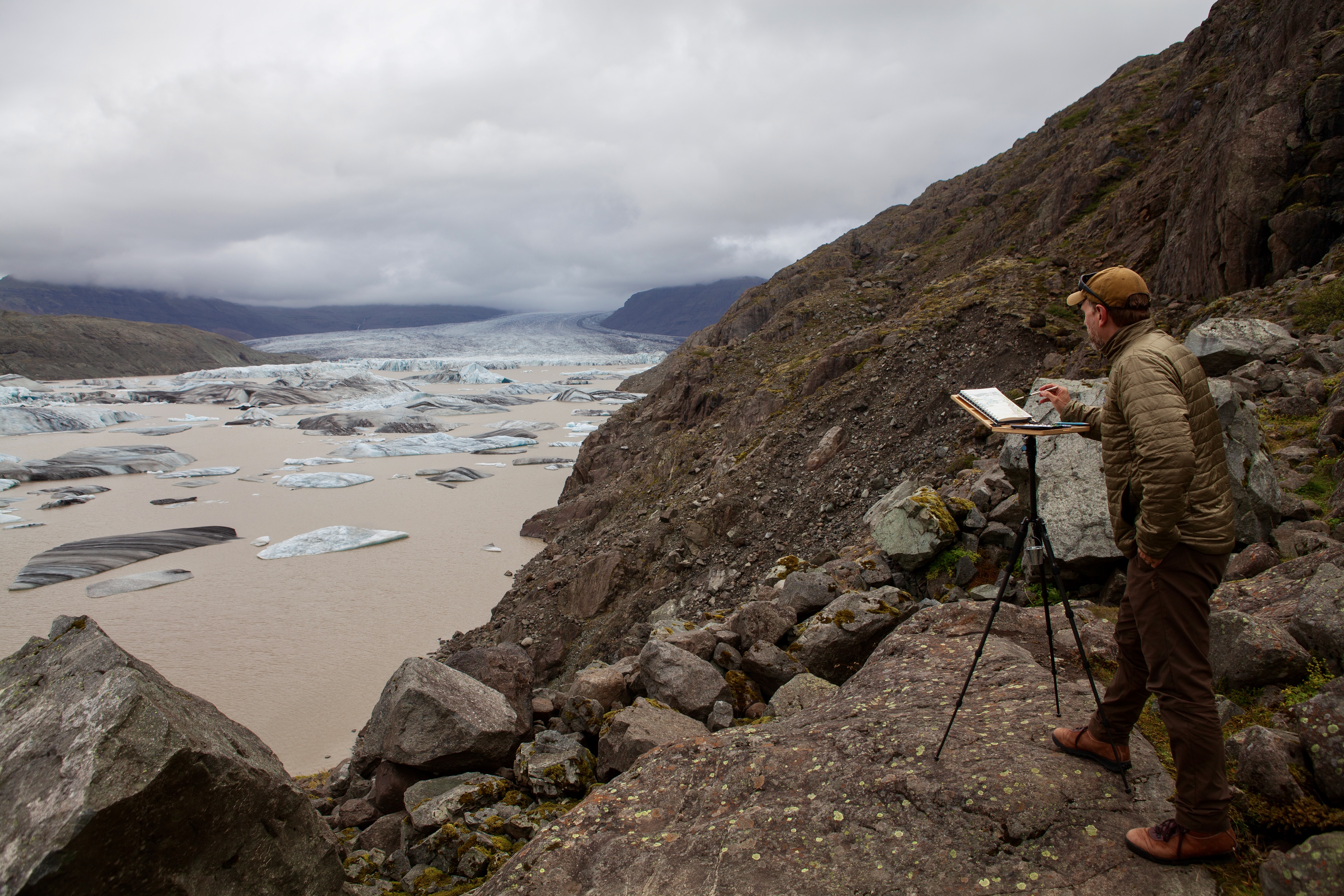
Frank Webster is a painter who lives in Queens, NY.
Webster received his BFA from the School of the Art Institute of Chicago and his MFA from the Mason Gross School of the Arts, Rutgers University. He also attended the Skowhegan School of Painting and Sculpture. Webster is the recipient of numerous awards including the NYFA Fellowship in Painting and the Pollock Krasner Award. He has been awarded residencies at the Arctic Circle Residency, NES Artist Residency, The Sharpe Walentas Space Program, Painting Space 122, The Ucross Foundation, The Corporation of Yaddo and The MacDowell Colony among others. In the Spring of 2024 he presented a solo exhibition Earthed Lightning at Isabel Sullivan Gallery in New York.
Webster’s work—ranging from small, ethereal watercolors to 10-foot wide panoramic paintings—depicts both the nuanced allure of the natural world and humanity’s interdependent relationship with it. His formal exploration of this tenuous harmony with our ecosystem is apparent in all of his work.
During his time at the Fish Factory, Webster researched the region and documented the landscape with a primary focus on the glaciers of Iceland. Working between traditional en plein air painting and photography he collected inspiration for future works on paper and large scale studio paintings.
Linktree: https://linktr.ee/frankwebsterstudio
Instagram: https://www.instagram.com/frankwebsterstudio/
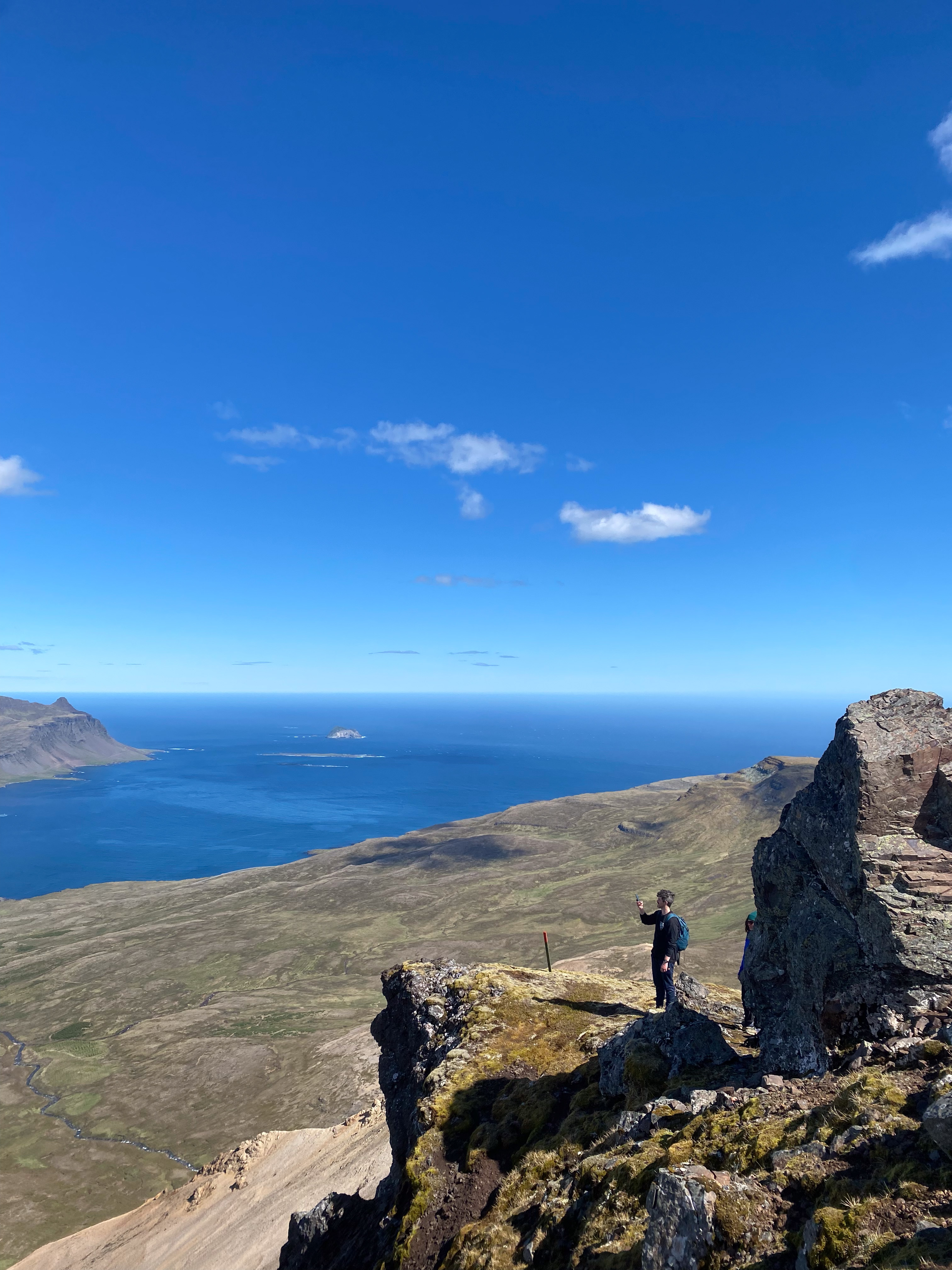
Tadhg is an artist from the west of Ireland, working in a variety of media, but with a background in painting and an interest in the tension between our perception of the world and the images we make to represent it.
At Fish Factory, I thought a lot about Petra’s Stone Museum and other ways we make sense of the world. I was very interested in the Fish Factory building itself, and its previous and current life as a workspace. I spent a lot of time wandering around it, taking photos, making rubbings, and looking at what the other artists were doing. I tried to slow down and not rush headlong in to making things for the sake of it. I spent most of my time drawing, writing, reading, and developing ideas for future works. I’m currently in the process of sifting through these ideas and seeing what might work.
Fish Factory was such a great environment for this kind of slow down, and one that I appreciate all the more since I have returned to “reality”! The other artists were a lovely bunch, and Kris, Una, and Vinnie looked after us well. I do hope I can get back there someday. Big Thank you to Galway County Council for helping to fund the trip.
Instagram: https://www.instagram.com/tadhg.o/
Website: http://www.tadhgocuirrin.com/